LG Electronics USA L15G Cellular/PCS GSM/WCDMA Phone with WLAN and Bluetooth User Manual
LG Electronics MobileComm USA, Inc. Cellular/PCS GSM/WCDMA Phone with WLAN and Bluetooth Users Manual
Users Manual

User Guide
LGL15G
MFL68803801 (1.0)
ENGLISH
www.lg.com

ENGLISH
User Guide
t Screen displays and illustrations may differ
from those you see on actual phone.
t Some of the contents of this guide may not
apply to your phone, depending on the software
and your service provider. All information in this
document is subject to change without notice.
t This handset is not suitable for people who
have a visual impairment due to the touch
screen keyboard.
t Copyright ©2014 LG Electronics, Inc. All rights
reserved. LG and the LG logo are registered
trademarks of LG Group and its related entities.
All other trademarks are the property of their
respective owners.
t Google™, Google Maps™, Gmail™,
YouTube™, Hangouts™ and Google Play™
are trademarks of Google, Inc.

2
Table of contents
Important notice ................................. 5
Getting to know your phone ............. 11
Phone overview ............................... 11
Installing the battery ........................ 14
Charging the phone ......................... 16
Using the memory card.................... 17
Locking and unlocking the screen .... 18
Your Home screen ............................. 19
Touch screen tips ............................ 19
Home screen ................................... 20
Customizing the Home screen ........ 21
Notifications .................................... 22
Accessing notifications ................... 22
Quick Settings ............................... 22
Notification icons on the
Status Bar ..................................... 24
Entering text .................................... 26
Entering special characters ............ 26
Google account setup ....................... 27
Connecting to Networks and
Devices .............................................. 29
Wi-Fi ............................................... 29
Connecting to Wi-Fi networks ......... 29
Turning Wi-Fi on and connecting
to a Wi-Fi network.......................... 29
Bluetooth ......................................... 30
Connecting to Virtual Private
Networks ......................................... 32
PC connections with a USB cable ..... 33
Calls .................................................. 35
Making a call ................................... 35
Calling your contacts ....................... 35
Answering and rejecting a call ......... 35
Adjusting the in-call volume ............. 36
Making a second call ....................... 36
Viewing your call logs ...................... 37
Call settings ..................................... 37
Contacts ............................................ 38
Searching for a contact .................... 38
Adding a new contact ...................... 38
Favorite contacts ............................. 39
Creating a group .............................. 39
Messaging ......................................... 40
Sending a message ......................... 40
View mode for the Messaging app ... 41
Changing your message settings ..... 41

3
Email ................................................. 42
Managing an email account ............. 42
Working with account folders ........... 43
Composing and sending email ......... 43
Camera and Video ............................. 44
Getting to know the viewfinder ........ 44
Using the advanced settings ............ 45
Taking a photo ................................ 46
Once you've taken a photo............... 46
Viewing your saved photos and
videos .............................................. 48
Recording a video ............................ 48
After recording a video..................... 49
Watching your saved videos ............ 49
Adjusting the volume when
viewing a video ................................ 49
Unique LG Features ........................... 50
Guest Mode ..................................... 50
Knock Code ..................................... 50
KnockON ......................................... 51
QuickMemo+ ................................... 51
Using the QuickMemo+ options ...... 53
QuickMemo+ Menu Options ........... 53
To exit the QuickMemo+ feature ..... 54
Viewing saved memos ................... 54
Multimedia ........................................ 55
Gallery ............................................. 55
Viewing pictures ............................ 55
Playing videos ............................... 56
Editing photos................................ 56
Deleting images ............................. 56
Setting a photo as the wallpaper ..... 56
Videos ............................................. 57
Playing a video .............................. 57
Music .............................................. 58
Playing a song ............................... 58
Tools .................................................. 60
Setting your alarm ........................... 60
Using your calculator ....................... 60
Adding an event to your calendar ..... 61
Tasks ............................................... 61
Voice Recorder ................................ 62
Recording a sound or voice ............ 62
Polaris Office ................................... 62
Google+ .......................................... 63
Voice Search.................................... 63
Downloads ...................................... 63

Table of contents
4
Browsing the Web............................. 64
Browser ........................................... 64
Using the Browser toolbar .............. 64
Viewing webpages ......................... 65
Opening a page ............................. 65
Searching the web by voice ............ 65
Bookmarks .................................... 65
History .......................................... 65
Chrome ........................................... 66
Viewing webpages ......................... 66
Opening a page ............................. 66
Searching the web by voice ............ 66
Syncing with other devices ............. 66
Access bookmarks ......................... 67
Settings ............................................. 68
Access the Settings menu ............... 68
Wireless Networks settings .............. 68
Device settings ................................ 70
Personal settings ............................. 75
System settings ............................... 79
Phone software update .................... 84
Accessories ....................................... 86
FAQ .................................................... 87
For your safety .................................. 93

5
Important notice
Please read this before you start using your phone!
Please check to see whether any problems you encountered with your phone are
described in this section before taking the phone in for service or calling a service
representative.
1. Phone memory
When there is less than 10MB of space available in your phone memory, your
phone cannot receive new messages. You need to check your phone memory
and delete some data, such as applications or messages, to make more memory
available.
To uninstall applications:
1 From the Home screen, tap > Apps tab (if necessary) > Settings >
Apps.
2 Once all applications appear, scroll to and select the application you want to
uninstall.
3 Tap Uninstall, then tap OK to confirm.
2. Optimizing battery life
Extend your battery's life between charges by turning off features that you
don't need to have running constantly in the background. You can monitor how
applications and system resources consume battery power.

6
Important notice
Extending your phone's battery life:
t Turn off radio communications when you're not using. If you are not using Wi-Fi,
Bluetooth or Location, turn them off.
t Reduce screen brightness and set a shorter screen timeout.
t Turn off automatic syncing for Gmail, Calendar, Contacts and other applications.
t Some applications you have downloaded may reduce battery power.
To check the battery power level:
t From the Home screen, tap > Apps tab (if necessary) > Settings >
About phone > Battery.
The battery status (charging or discharging) and battery level (percentage charged)
is displayed.
To monitor and control how battery power is being used:
t From the Home screen, tap > Apps tab (if necessary) > Settings >
About phone > Battery > Battery use.
Battery usage time is displayed on the screen. It tells you how long it has been
since you last connected your phone to a power source or, if currently connected,
how long the phone was last running on battery power. The screen shows the
applications or services using battery power, listed in order from the greatest to
smallest amount used.

7
3. Before installing an open source application and
operating system (OS)
WARNING
If you install and use an OS other than the one provided by the
manufacturer it may cause your phone to malfunction. In addition, your
phone will no longer be covered by the warranty.
WARNING
To protect your phone and personal data, only download applications
from trusted sources, such as Play Store. If there are improperly installed
applications on your phone, the phone may not work normally or a
serious error may occur. You must uninstall those applications and all
associated data and settings from the phone.
4. Using a screen lock
Set a screen lock to secure your phone and prevent unauthorized use. From the
Home screen, tap > Apps tab (if necessary) > Settings > Lock screen
> Select screen lock > Knock Code, Pattern, PIN, or Password. Some options
will prompt you to create a Backup PIN as a safety measure in case you forget
your screen lock.
Caution: Create a Google account before setting a screen lock and
remember the Backup PIN you created when creating your screen lock.

8
Important notice
WARNING
Precautions to take when using a screen lock.
It is very important to remember the screen lock you set. You will not be
able to access your phone if you use an incorrect screen lock 5 times. If
you have used all 5 opportunities, you can try again after 30 seconds.
5. Using Hard Reset (Factory Reset)
If your phone needs to be restored to its original condition, use a Hard Reset to
initialize your phone.
WARNING
If you perform a Hard Reset, all user applications and user data will
be deleted. Please remember to back up any important data before
performing a Hard Reset.
1 Turn the phone off.
2 Press and hold the Power/Lock Key + Volume Down Key at the same time.
3 Release only the Power/Lock Key when the LG logo is displayed, then
immediately press and hold it again.
4 Release all of the keys when the Factory data reset screen is displayed.
5 Press the Volume Down Key to scroll to Yes, then press the Power/Lock Key
to confirm.

9
6 Press the Volume Down Key to scroll to Yes once again, then press the
Power/Lock Key to confirm.
7 Your phone performs a factory reset.
6. Opening and switching applications
Multi-tasking is easy with Android because you can keep more than one
application running at the same time. There is no need to quit an application
before opening another one. Use and switch between several open applications.
Android manages each application, stopping and starting them as needed to
ensure that idle applications don't consume resources unnecessarily.
To stop applications:
1 From the Home screen, tap > Apps tab (if necessary) > Settings >
Apps > RUNNING tab.
2 Tap the desired application and tap Stop to stop it.
7. Transferring music, photos and videos using
Media device (MTP)
1 Connect the phone to your PC using the USB cable provided with your phone.
2 Drag the Status Bar down and tap the current USB connection.
3 Tap the Media device (MTP) option.
4 Select the Open device to view files option on your PC. You can then view
media contents on your PC and transfer the files.
5 Copy the files from your PC to the drive folder or vice versa.

10
Important notice
6 Drag the Status Bar down and tap Media device (MTP) > Charge phone.
7 Disconnect the USB cable from your phone.
8. Hold your phone upright
Hold your cell phone vertically, as you would a regular phone. Your phone has an
internal antenna. Be careful not to scratch or damage the back of the phone, as
this may affect performance.
When making/receiving calls or sending/receiving data, avoid holding the lower
part of the phone where the antenna is located. Doing so may affect call quality.

11
Getting to know your phone
Phone overview
Proximity Sensor
Earpiece
Home Key
Return to the Home screen from any
screen. Press and hold to access Google
Now.
Volume Keys
Allow you to adjust the
ringer, media volume, or
the volume during a call.
Back Key
Return to the previous
screen.
Recent Apps Key
Power/Lock Key
Turn your phone on/off,
restart, lock/unlock the
screen, turn airplane mode
on or off, and change the
ringer type.
WARNING
Placing a heavy object on the phone or sitting on it can damage the
LCD and touchscreen functions. Covering the proximity sensor with a
protective film could cause the sensor to malfunction.

12
Getting to know your phone
Microphone
Charger/
USB Port
3.5mm Headset Jack
Power/Lock Key
Volume Keys
t On the Home screen: Control
ringer volume.
t During a call: Control your
earpiece volume.
t When playing audio/video:
Control volume continuously.
NOTE: You may purchase a separate fast data cable from LG for higher
data transfer speed with compatible devices (e.g. laptop).

13
Back cover
Battery
microSD Card slot
Camera Lens
Speaker

14
Getting to know your phone
Installing the battery
Before you can start using your new phone, you'll need to do a little setup, such as
installing and charging the battery.
1 To remove the back cover, hold the phone firmly in one hand. With your other
hand, place your thumbnail in the Charger/USB Port at the bottom of the phone
as shown in the illustration below.
NOTE: Make sure to turn the phone off before removing the battery.

15
2 Insert the battery into the battery compartment on the back on the phone. Make
sure the connectors align
1
and press down until it clicks into place
2
.
3 Align the back cover over the battery compartment
1
and press down along
the outer edges of back cover
2
.

16
Getting to know your phone
Charging the phone
Your phone comes with a USB cable and a charging adapter. Fully charge the
battery before using your phone for the first time to improve your battery lifetime.
The USB/Charging Port is at the bottom of the phone. Insert one end of the USB
cable into the port and plug the charging adapter into an electrical outlet.
WARNING
To avoid damage to your phone's USB/Charging Port and USB cable
plug, orient the plug with the port before inserting it.

17
NOTE:
t Do not remove the back cover while your phone is charging.
t Only use an approved USB cable and charging adapter to charge your
LG phone. Improper handling of the USB/Charging Port, as well as the
use of an incompatible charger, may cause damage to your phone and
void the warranty.
Using the memory card
Make sure to unmount the SD card in the Storage menu before removing it.
1 Remove the back cover.
2 Insert the memory card into the slot. Make sure the gold contact area is facing
downwards.

18
Getting to know your phone
Locking and unlocking the screen
If you do not use the phone for a while, the screen will be automatically turned off
and locked. This helps to prevent accidental taps and saves battery power.
When you are not using your phone, press the Power/Lock Key to lock your
phone.
If there are any programs running when you lock your screen, they may be still
running in Lock mode. It is recommended that you exit all programs before
entering Lock mode to avoid unnecessary charges (e.g. phone calls, web access
and data communications).
To wake up your phone, press the Power/Lock Key . The Lock screen will
appear. Touch and slide the Lock screen in any direction to unlock the screen. The
last screen you viewed will open.

19
Your Home screen
Touch screen tips
Here are some tips on how to navigate on your phone.
Touch or tap – A single finger tap selects items, links, shortcuts and letters on the
on-screen keyboard.
Touch and hold – Touch and hold an item on the screen by touching it and not
lifting your finger until an action occurs. For example, to open a contact's available
options, touch and hold the contact in the Contacts list until the context menu
opens.
Drag – Touch and hold an item for a moment and then, without lifting your finger,
move your finger on the screen until you reach the target position. You can drag
items on the Home screen to reposition them.
Swipe or slide – To swipe or slide, quickly move your finger across the surface
of the screen, without pausing when you first touch it (so you don't drag an item
instead). For example, you can slide the screen up or down to scroll through a list
or browse through the different Home screens by swiping from left to right (and
vice versa).
Double-tap – Double-tap to zoom on a webpage or a map. For example, quickly
double-tap a section of a webpage to adjust that section to fit the width of the
screen. You can also double-tap to zoom in and out when viewing a picture and
when using maps.
Pinch-to-Zoom – Use your index finger and thumb in a pinching or spreading
motion to zoom in or out when using the browser, maps or when viewing pictures.
Rotate the screen – From many applications and menus, the orientation of the
screen adjusts to the device's physical orientation.

20
Your Home screen
NOTE:
t To select an item, tap the center of the icon.
t Do not press too hard; the touch screen is sensitive enough to pick up
a light, yet firm tap.
t Use the tip of your finger to tap the option you want. Be careful not to
tap any other keys.
Home screen
Simply swipe your finger to the left or right to view the Home screen panels. You
can customize each panel with pre-loaded and downloaded apps, widgets, and
wallpapers.
The Quick Keys are available at the bottom of the Home screen. Quick Keys
provide easy and one-tap access to the functions you use the most.
Tap the Phone icon to bring up the dialpad to make a call.
Tap the Contacts icon to open your contacts.
Tap the Messaging icon to access the Messaging application, where you
can view and create text and multimedia messages.
Tap the Apps icon to view all of your installed applications. To open any
application, simply tap the icon in the applications list.
NOTE: To add an icon, drag it to the Quick Keys bar and release it. To
remove an icon, drag it out of the Quick Keys bar.

21
Customizing the Home screen
You can customize your Home screen by adding apps, downloads, widgets or
wallpapers. For more convenience using your phone, add your favorite apps and
widgets to the Home screen.
To add items on your Home screen:
1 Touch and hold the empty part of the Home screen.
2 Tap the desired tab. Choose from Apps or Widgets.
3 Drag the desired app icon to the preferred location and lift your finger.
To remove an item from the Home screen:
t Touch and hold the icon you want to remove, then drag it to and release it.
TIP! To add an application icon to the Home screen from the Apps
screen, touch and hold the application you want to add and drag it to
the desired location.
TIP! Using folders
You can combine several app icons in a folder to help keep you
organized. Drop one app icon over another one on a Home screen and
a folder will be created with both icons in it.
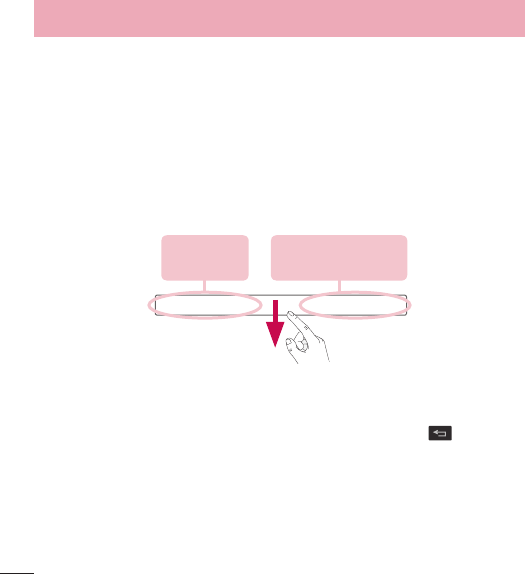
22
Your Home screen
Notifications
Notifications alert you to the arrival of new messages, calendar events, and
alarms, as well as to ongoing events, such as video downloads.
From the Notifications Panel, you can view your phone's current status and
pending notifications.
When a notification arrives, its icon appears at the top of the screen. Icons for
pending notifications appear on the left and system icons, such as Wi-Fi or bat tery
strength, on the right.
Pending
notifications System notifications
Accessing notifications
Swipe the Status Bar downwards to open the Notifications Panel. To close the
Notifications Panel, swipe the panel upwards or tap the Back Key .
Quick Settings
Use the Quick Settings to easily toggle function settings like Wi-Fi, manage display
brightness and more. To access the Quick Set tings, open the Notifications Panel.
The Quick Settings bar is located at the top of the Notifications Panel.
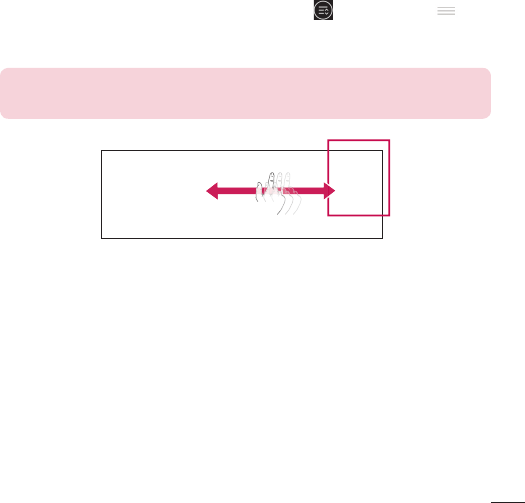
23
To rearrange Quick Setting items on the Notification Panel
Swipe the Quick Settings bar to the left and tap Edit . Touch and hold
next to the items you want to move and drag it to the desired location. Tap the
checkbox next to each item to add and remove them from the Quick Settings bar.
NOTE: Touch and hold an icon on the Quick Settings bar to directly
access its settings menu.
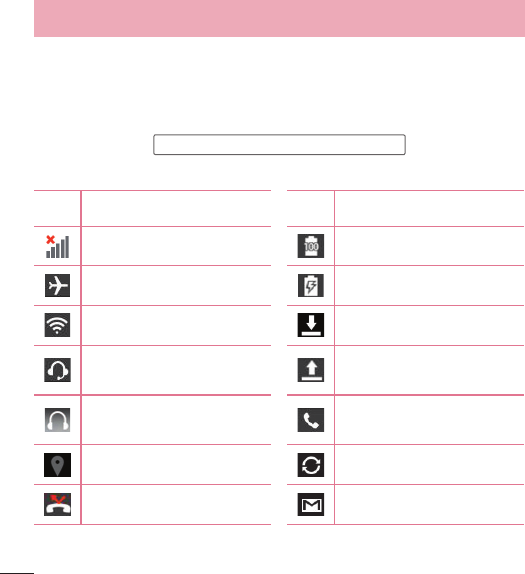
24
Your Home screen
Notification icons on the Status Bar
Notification icons appear on the Status Bar at the top of the screen to report
missed calls, new messages, calendar events, device status and more.
The icons listed in the table below are some of the most common ones.
Icon Description Icon Description
No signal Battery fully charged
Airplane mode Battery is charging
Connected to a Wi-Fi network Downloading data
Wired headset (with mic)
connected Uploading data
Wired headset (with no mic)
connected Call in progress
Acquiring GPS Data is syncing
Missed call New Gmail message
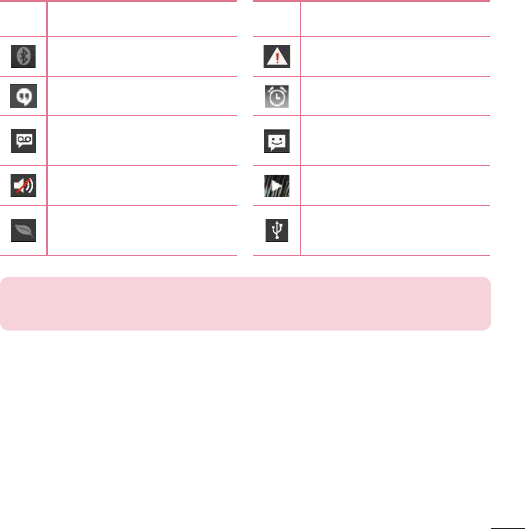
25
Icon Description Icon Description
Bluetooth is on System warning
New Hangouts message Alarm is set
New voicemail New text or multimedia
message
Ringer is silenced Song is playing
Battery saver is on Phone is connected to PC via
USB cable
NOTE: The icon locations in the Status Bar may differ depending on the
functions, features, and apps being used.

26
Your Home screen
Entering text
You can enter text using the on-screen keyboard. The on-screen keyboard appears
automatically on the screen when you need to enter text. To manually display the
keyboard, simply tap a text field where you want to enter text.
Using the keyboard and entering text
Tap once to capitalize the next letter you type. Double-tap for all caps (the
arrow turns blue).
Tap to switch to the numbers and symbols keyboard.
Tap to access the LG Keyboard settings. Touch and hold to access voice input
mode.
Tap to enter a space.
Tap to create a new line in the text field.
Tap to delete the previous character.
Entering special characters
The LG Keyboard allows you to enter special characters (e.g. “á”) when entering
text.
For example, to enter “á”, touch and hold the “a” key. When the pop-up with its
additional characters is displayed, slide your finger over the "á", then lift your
finger to enter it.

27
Google account setup
The first time you open a Google app on your phone, you'll be required to sign in
with your existing Google Account. If you don't have a Google Account, you'll be
prompted to create one.
Creating your Google Account
1 From the Home screen, tap > Apps tab (if necessary) > Settings .
2 Tap Accounts & sync > Add account > Google > New to start the Google
Account set up wizard.
3 Tap a text field to open the keyboard and enter your name and username for
your Google Account. When entering text, you can move to the next text field by
tapping Next on the keyboard.
4 When you have finished entering your name and username, tap the Next
icon . Your phone then communicates with Google servers and checks for
username availability.
5 Enter and re-enter your password. Then follow the instructions and enter the
required and optional information about the account. Wait while the server
creates your account.

28
Google account setup
Signing in to your Google Account
1 From the Home screen, tap > Apps tab (if necessary) > Settings >
Accounts & sync > Add account > Google > Existing.
2 Enter your email address and password, then tap the Next icon .
3 Once you've set up your Google Account on your phone, it'll automatically
be synchronized with your Google Account on the web (depending on your
synchronization settings).
After signing in, you can use Gmail and Play Store; back up your settings to
Google servers; and take advantage of other Google services on your phone.

29
Connecting to Networks and Devices
Wi-Fi
With Wi-Fi, you can use high-speed Internet access within the coverage of the
wireless access point (AP). Enjoy wireless Internet using Wi-Fi, without extra
charges.
Connecting to Wi-Fi networks
To use Wi-Fi on your phone, you need to access a wireless access point or
'hotspot'. Some access points are open and you can simply connect to them.
Others are hidden or use security features and you must configure your phone to
be able to connect to them.
Turn off Wi-Fi when you're not using it to extend the life of your battery.
NOTE: If you are out of the Wi-Fi zone or have set Wi-Fi to off, additional
charges may be applied by your mobile service provider for mobile data
use.
Turning Wi-Fi on and connecting to a Wi-Fi network
1 From the Home screen, tap > Apps tab (if necessary) > Settings >
Wi-Fi.
2 Tap the switch to turn Wi-Fi on and start scanning for available Wi-Fi
networks.
t Secured networks are indicated by a lock icon.
3 Tap a network to connect to it.
t If the network is secured, you are prompted to enter a password or other
credentials. (Ask your network administrator for details)

30
Connecting to Networks and Devices
4 The Status Bar displays icons that indicate your Wi-Fi status.
Bluetooth
Bluetooth allows you to share data with other Bluetooth-enabled devices and
connect to Bluetooth headsets.
NOTE:
t LG is not responsible for the loss, interception or misuse of data sent
or received via the Bluetooth wireless feature.
t Always ensure that you share and receive data with devices that are
trusted and properly secured. If there are obstacles between the
devices, the operating distance may be reduced.
t Some devices, especially those that are not tested or approved by
Bluetooth SIG, may be incompatible with your device.
Turning on Bluetooth and pairing up your phone with a Bluetooth device
You must pair your phone with another device before you connect to it.
1 From the Home screen, tap > Apps tab (if necessary) > Settings >
Bluetooth.
2 Tap the switch to turn Bluetooth on.
3 Tap the check box next to your phone's name to make your phone visible to
other Bluetooth devices.
NOTE: To select the length of time that your device will be visible, tap
the Menu icon > Visibility timeout.

31
4 A list of available devices will be displayed. Choose the device you want to pair
with from the list.
5 Depending on the type of device, you may have to enter matching codes,
confirm matching codes, or the devices will automaticall pair.
Once the paring is successful, your device will connect to the other device.
NOTE: Some devices, especially headsets or hands-free car kits, may
have a fixed Bluetooth PIN, such as 0000. If the other device has a PIN,
you will be asked to enter it.
Send data using the Bluetooth wireless feature
1 Select a file or item, such as a contact, calendar event or media file, from an
appropriate application or from the Downloads app.
2 Select the option for sending data via Bluetooth.
NOTE: The method for selecting an option may vary by data type.
3 Search for and pair with a Bluetooth-enabled device (if necessary).
Receive data using the Bluetooth wireless feature
1 Pair both devices and send a file from the other device to yours.
2 Tap Accept to confirm that you are willing to receive data from the device.

32
Connecting to Networks and Devices
Connecting to Virtual Private Networks
Virtual private networks (VPNs) allows you to connect to resources inside a secure
local network, from outside that network.
To add a VPN
1 From the Home screen, tap > Apps tab (if necessary) > Settings >
More... > VPN.
NOTE: You must configure a screen lock to use VPN.
2 Tap Add VPN network.
3 Tap the type of VPN you want to add.
4 In the screen that opens, follow the instructions from your network administrator
to configure each component of the VPN settings.
5 Tap Save. The VPN will be added to the list on the VPN settings screen.

33
PC connections with a USB cable
Learn to connect your device to a PC with a USB cable using the different USB
connection modes.
Transferring music, photos and videos using Media device (MTP)
1 Connect your phone to a PC using the USB cable provided with your phone.
2 Drag the Status Bar down and tap the current USB connection.
3 Tap the Media device (MTP) option.
Synchronize with Windows Media Player
Ensure that Windows Media Player is installed on your PC.
1 Use the USB cable to connect the phone to a PC on which Windows Media
Player has been installed.
2 Select the Media device (MTP) option. When connected, a pop-up window will
appear on the PC.
3 Open Windows Media Player to synchronize music files.
4 Edit or enter your device's name in the pop-up window (if necessary).
5 Select and drag the music files you want to the sync list.
6 Start synchronization.
t The following requirements must be satisfied to synchronize with Windows
Media Player.

34
Connecting to Networks and Devices
Items Requirement
OS Microsoft Windows XP SP2, Vista or higher
Window Media Player version Windows Media Player 10 or higher
t If the Windows Media Player version is lower than 10, install version 10 or
higher.
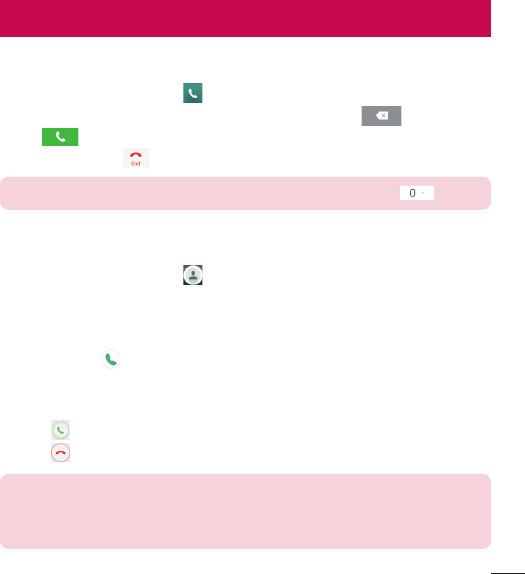
35
Calls
Making a call
1 From the Home screen, tap to open the dial pad.
2 Enter the number using the dial pad. To delete a digit, tap .
3 Tap to make a call.
4 To end a call, tap .
TIP! To enter “+” to make international calls, touch and hold .
Calling your contacts
1 From the Home screen, tap to open your contact list.
2 Scroll through the contact list or tap the Search contacts box and enter the
contacts name. You can also scroll the alphabet bar along the right side of the
screen.
3 In the list, tap next to the desired contact to make the call.
Answering and rejecting a call
t Swipe in any direction to answer the incoming call.
t Swipe in any direction to decline an incoming call.
TIP! Decline with message
You can send a message quickly using this function. This is useful if you
need to reject a call during a meeting.

36
Calls
Adjusting the in-call volume
To adjust the in-call volume during a call, use the Volume Up and Volume Down
Keys on the left side of the phone.
Making a second call
1 During your first call, tap Menu icon , touch Add call and dial the number.
You can also go to the recently dialed numbers list by tapping Call logs or
search contacts by tapping Contacts and selecting the contact you want to call.
2 Tap to make the call.
3 Your initial call is placed on hold.
4 Tap if you want to start a conference call.
5 To end active calls, tap .
NOTE: You are charged for each call you make.
TIP! Tap Manage members to end or separate individual calls from the
conference call.

37
Viewing your call logs
From the Home screen, tap and choose the Call logs tab. A complete list of all
dialed, received and missed calls is displayed.
TIP!
t Tap any call log entry to view the date, time and duration of the call.
t Tap the Menu icon , then tap Delete all to delete all the recorded
items or tap Delete to delete individual items.
Call settings
You can configure phone call settings such as call forwarding, as well as other
special features offered by your provider.
1 From the Home screen, tap .
2 Tap the Menu icon .
3 Tap Call settings and choose the options that you wish to adjust.

38
Contacts
Add contacts to your phone and synchronize them with the contacts in your
Google account or other accounts that support contact syncing.
Searching for a contact
1 From the Home screen, tap to open your contact list.
2 Tap the Search contacts box and enter the contacts name. You can also scroll
the alphabet bar along the right side of the screen.
Adding a new contact
1 From the Home screen, tap and enter the new contact's number.
2 Tap the Menu icon > Add to Contacts > New contact.
3 If you want to add a picture to the new contact, tap . Choose from Take
photo or Select from Gallery.
4 Tap at the top of the screen and select the account you want to save the
contact to.
5 Tap a category of contact information and enter the details about your contact.
6 Tap Save.

39
Favorite contacts
You can classify frequently called contacts as favorites.
Adding a contact to your favorites
1 From the Home screen, tap to open your contact list.
2 Tap a contact to view its details.
3 Tap the star at the top right corner of the screen. The star will turn yellow.
Removing a contact from your favorites list
1 From the Home screen, tap to open your contact list.
2 Tap the Favorites tab and choose a contact to view its details.
3 Tap the yellow color star at the top right corner of the screen. The star turns
gray and the contact is removed from your favorites.
Creating a group
1 From the Home screen, tap to open your contact list.
2 Tap the Groups tab, then tap the Menu icon > New group.
3 Enter a name for the new group. You can also set a ringtone for the newly
created group.
4 Tap Add members to add contacts to the group.
5 Tap Save to save the group.
NOTE: If you delete a group, the contacts assigned to that group will
not be lost. They will remain in your contacts.
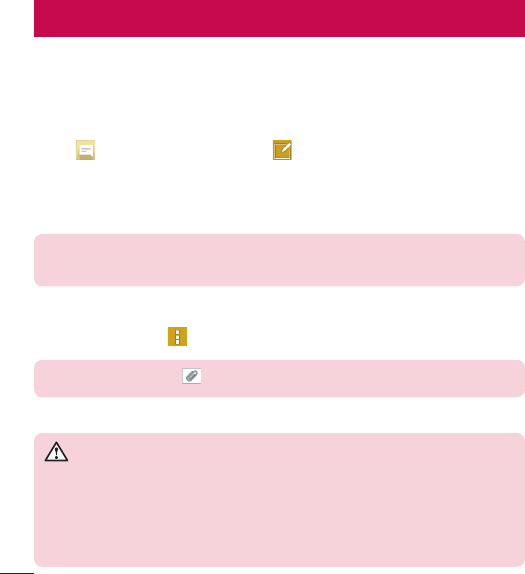
40
Messaging
Your phone combines text and multimedia messages into one intuitive, easy-to-
use menu.
Sending a message
1 Tap on the Home screen and tap to compose a new message.
2 Enter a contact name or contact number in the To field. As you enter the
contact name, matching contacts will appear. You can tap a suggested
recipient. You can add more than one contact.
NOTE: You will be charged for each text message you send to every
person.
3 Tap the text field and begin composing your message.
4 Tap the Menu icon to access the messaging options.
TIP! You can tap the icon to attach a file you want to share.
5 Tap Send to send your message.
WARNING
t The 160-character limit may vary from country to country, depending
on the language and how the text message is coded.
t If an image, video or audio file is added to an text message, it is
automatically converted into a multimedia message and you are
charged accordingly.

41
View mode for the Messaging app
Unread messages are located at the top. Other messages exchanged with
another party are displayed in threads and in chronological order so that you can
conveniently see an overview of your conversation.
Changing your message settings
Your phone message settings are pre-defined, so you can send messages
immediately. You can change the settings according to your preferences.
t Open the Messaging app and tap the Menu icon > Settings.

42
Email
You can use the Email application to read emails from services like Gmail. The
Email application supports the following account types: POP3, IMAP and Exchange.
Your service provider or system administrator can provide you with the account
settings you need.
Managing an email account
The first time you open the Email application, a setup wizard opens to help you to
set up an email account.
After the initial setup, the Email application displays the contents of your inbox. If
you have added more than one account, you can switch among accounts.
To add another email account:
t Open the Email application and tap the Menu icon > Settings > Add
account.
To change an email account's settings:
t Open the Email application and tap the Menu icon > Settings. Then tap
General settings to configure settings for all accounts or tap an individual
account to configure settings only for that particular account.
To delete an email account:
t Open the Email application and tap the Menu icon > Settings > Menu
icon > Remove account > tap an account > Remove > Yes.

43
Working with account folders
Open the Email application and tap the Menu icon > Folders.
Each account has an Inbox, Outbox, Sent and Drafts folder. Depending on the
features supported by your account's service provider, you may have additional
folders.
Composing and sending email
To compose and send a message
1 While in the Email application, tap .
2 Enter an address for the message's intended recipient. As you enter text,
matching addresses will be proposed from your Contacts. Separate multiple
addresses using semicolons.
3 Tap the Cc/Bcc field to copy recipients. Tap to attach files, if needed.
4 Tap the message field and enter your message.
5 Tap to send the email.
If you aren't connected to a network, for example, if you're working in airplane
mode, the messages that you send will be stored in your Outbox folder until you
connect to a network again.
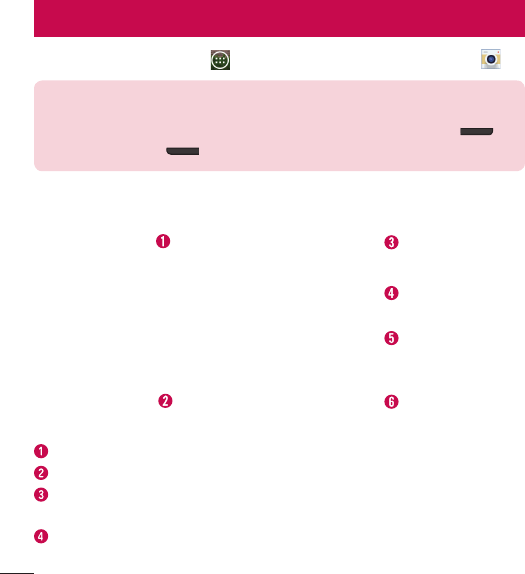
44
Camera and Video
To open the Camera app, tap from the Home screen, then tap Camera .
TIP! You can quickly access the Camera app without unlocking your
phone first.
t While the screen is off, press and hold the Volume Down Key or
Volume Up Key on the left side of the phone.
Getting to know the viewfinder
Menu – Tap to display camera options on the viewfinder screen.
Settings – Tap this icon to open the settings menu.
Gallery – Tap to view the last photo or video you captured. This enables you to
access your Gallery and view saved photos and videos while in camera mode.
Record – Tap to start recording a video.
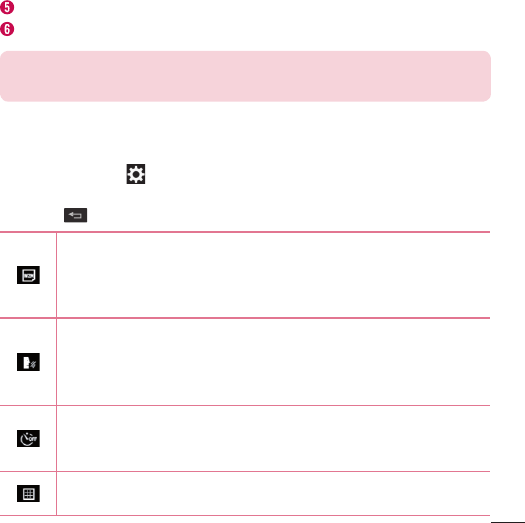
45
Capture – Tap to capture a photo.
Back Key – Tap to exit the camera.
NOTE: The memory capacity may differ depending on how you
configure your camera settings.
Using the advanced settings
In the viewfinder, tap to open the advanced options. You can change the
camera settings by scrolling through the list. After selecting the option, tap the
Back Key .
This option sets the image and video size (resolution).
Choose from 3M(2048x1536), W2M(2048x1350), 2M(1536x1536)
and 1M(1280x960) for pictures. For videos, the option is
WVGA(800x480).
This option enables you to take a picture using a voice command.
Choose On or Off.
If set to On, say Cheese, Smile, Whiskey, Kimchi, or LG to take a
photo.
This option sets a delay after the Capture/Record button is tapped. This
is ideal if you want to be in the photo or video.
Choose from Off, 3 sec, and 10 sec.
This option displays grid lines so that you can easily take pictures and
record videos.

46
Camera and Video
This option sets the location where you want to save your images and
videos.
Choose SD card or Internal storage. This menu is displayed only
when the microSD card is inserted.
This option provides a quick help guide.
Taking a photo
1 Open the Camera app.
2 Point the lens toward the subject you want to photograph.
3 Tap the Capture button to take the photo.
Once you've taken a photo
1 Tap the image preview next to the Record button to view the last photo you
captured.
2 Tap Gallery, then tap OK.
TIP! To make one of the available apps the default viewing app, make
sure that the Use as default app option is selected.
NOTE: You can also choose the Photos app to view and edit your
photo.

47
The following icons appear at the top of the Gallery screen:
Tap to edit the photo (such as cropping, rotating, tuning, adding
effects, and more).
Tap to take another photo immediately.
Tap to send your photo to others or share it via social network services.
Tap to delete the photo.
Tap to set the picture to your Favorites folder.
Tap the Menu icon to open the following advanced options.
Set image as – Tap to use the photo as a Contact photo, Home screen
wallpaper, Lock screen wallpaper, or Wallpaper.
Move – Tap to move the photo or video to another album.
Copy – Tap to copy the selected photo or video and save it to another album.
Slideshow – Tap to display a slideshow using all of your photos.
Rotate left/right – Tap to rotate the picture to the left or right.
Crop – Tap to crop your photo.
Add location – Tap to add location information to your photo.
Rename – Tap to change the name of the selected photo or video.
Print – Tap to print the photo.
Details – Tap to display information about the photo or video.

48
Camera and Video
Viewing your saved photos and videos
You can access your saved photos and videos when in camera mode. Just tap the
image preview next to the Record button.
1 Choose the app to use to view and/or edit your photos.
2 Tap Gallery or Photos, then tap OK.
t To view more photos, scroll left or right.
t To zoom in or out, double-tap the screen or place two fingers and spread
them apart (move your fingers closer together to zoom out).
Recording a video
1 Open the Camera app.
2 The video camera viewfinder appears on the screen.
3 Point the lens toward the subject you want to capture in your video.
4 Tap the Record button once to start recording.
5 A timer showing the length of the video is displayed.
6 Tap the Stop button to stop recording.
NOTE:
t Tap to capture a screen shot while you record.
t Tap to pause while recording a video.
t While recording a video, place two fingers on the screen and pinch to
use the Zoom function.
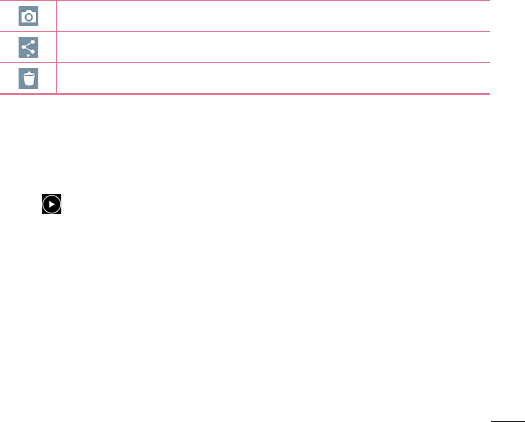
49
After recording a video
Tap the image preview next to the Record button to view the last video you
recorded.
The following icons appear at the top of the Gallery screen:
Tap to record another video immediately.
Tap to send your video to others or share it via social network services.
Tap to delete the video.
Watching your saved videos
1 In the viewfinder, tap the image preview next to the Record button.
2 Your Gallery will appear on the screen.
3 Tap to play the video.
Adjusting the volume when viewing a video
To adjust the volume of a video while it is playing, use the Volume Keys on the left
side of the phone.

50
Unique LG Features
Guest Mode
To protect your privacy or limit some applications to your children, you can use the
Guest mode. When you lend your phone to others, you can limit the applications to
be displayed.
1 From the Home screen, tap > Apps tab (if necessary) > Settings >
Guest mode.
2 Tap Lock screen type to set the pattern used to enter Guest mode.
3 Tap Allowed app to select the apps you want to allow others to view under
Guest mode.
4 Tap Wallpaper to change the wallpaper for the Guest mode Home screen.
5 Tap the switch to enable Guest mode.
NOTE: If you have not set a lock code, you will be prompted to create
one.
Knock Code
The Knock Code feature allows you to instantly access your Home screen by
tapping a customized pattern anywhere on the screen.
To activate the Knock Code feature
1 From the Home screen, tap > Apps tab (if necessary) > Settings >
Lock screen > Select screen lock > Knock Code.

51
2 A screen that guides you through setting up a Knock Code will be displayed.
You have to create a Backup PIN as a safety measure in case you forget your
Knock Code.
KnockON
The KnockON feature allows you to turn the screen on and off by simply double
tapping on it.
Using KnockON
t When the screen is off, double-tap the center of it quickly to unlock it.
t To lock the screen, double-tap the Status Bar in any screen (except on the
camera viewfinder) or an empty area on the Home screen.
QuickMemo+
The QuickMemo+ feature allows you to capture screen shots and use them to
create memos. You can use QuickMemo+ to easily create memos during a call,
with a saved picture or on the current phone screen.
1 Access the QuickMemo+ feature by pressing
both Volume Keys for one second on the
screen you want to capture.
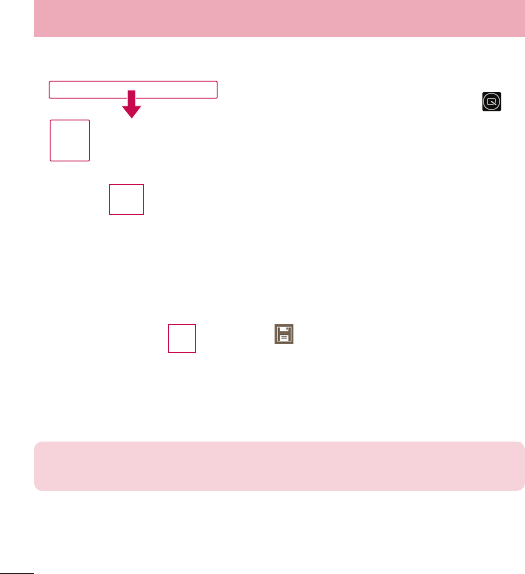
52
Unique LG Features
OR OR
Drag the Status Bar down and and tap on
the Quick Settings Bar.
2 Create a memo using the toolbar options.
3 Tap in the toolbar to save the memo to the
QuickMemo+ app or your Gallery.
NOTE: Please use a fingertip while using the QuickMemo+ function. Do
not use your fingernail.
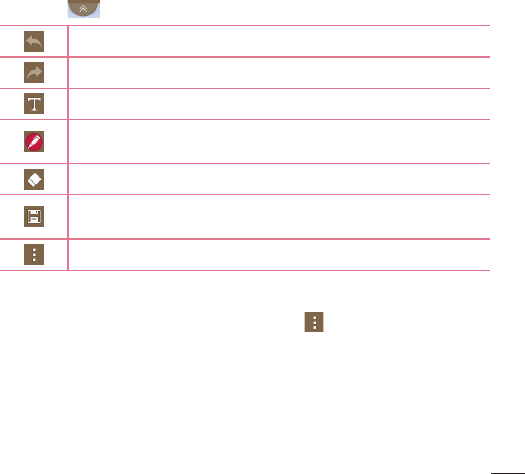
53
Using the QuickMemo+ options
The QuickMemo+ toolbar options allow you to easily create memos. Tap the
toolbar tab to access and hide the QuickMemo+ toolbar icons.
Tap to undo the most recent action.
Tap to redo the most recently deleted action.
Tap to type text in your memo.
Tap to select the pen type and color. You can also select its thickness
and transparency.
Tap to use the eraser to erase pen marks from the memo.
Tap to save the memo you’ve created to your Gallery or to the
QuickMemo+ app.
Tap to access additional options.
QuickMemo+ Menu Options
From the QuickMemo+ screen, tap the Menu icon to access the following
options.
t Tap Insert to insert files stored in your phone/memory card into the memo.
t Tap Move to move the current memo into another folder.
t Tap Delete to delete the current memo.
t Tap Export to export the current memo to internal storage or the SD card.
t Tap Share to share the memo with others.

54
Unique LG Features
t Tap Paper style to set the paper background for your memo.
To exit the QuickMemo+ feature
Tap the Back Key to exit the QuickMemo+ feature.
Viewing saved memos
Memos are saved in the Gallery app or QuickMemo+ app.
t From the Home screen, tap > the Apps tab (if necessary) > Gallery ,
then tap the QuickMemo+ album.
t From the Home screen, tap > the Apps tab (if necessary) > QuickMemo+
, then tap the your memo.

55
Multimedia
Gallery
You can store multimedia files in the internal and external memory for easy access
to all your multimedia files. Use this application to view multimedia files like
pictures and videos.
t From the Home screen, tap > Apps tab (if necessary) > Gallery .
NOTE:
t Some file formats are not supported, depending on the software
installed on the device.
t Some files may not play properly, depending on how they are
encoded.
Viewing pictures
Open the Gallery to display your available albums. When some applications save
a picture, a folder might be automatically created to contain the picture. For
example, capturing a screenshot automatically creates the Screenshots folder.
Pictures are displayed by creation date in a folder. Select a picture to view it full
screen. Scroll left or right to view the next or previous image.
Zooming in and out
Use one of the following methods to zoom in on an image:
t Double-tap anywhere to zoom in.
t Spread two fingers apart on any place to zoom in. Pinch to zoom out, or double-
tap to return.

56
Multimedia
Playing videos
Video files show the icon in the preview. Select a video to watch it and tap .
NOTE:
t Some file formats are not supported, depending on the device
software.
t If the file size exceeds the available memory, an error can occur when
you open files.
Editing photos
When viewing a photo, tap Edit and use the advanced editing options.
Deleting images
Use one of the following methods:
t In an album, tap and select photos/videos by tapping them, then tap Delete.
t When viewing a photo or video preview, tap .
Setting a photo as the wallpaper
When viewing a photo, tap the Menu icon and select Set image as to set the
image as the Home screen or Lock screen wallpaper.

57
Videos
Your phone has a video player that lets you play all of your favorite videos.
Playing a video
1 From the Home screen, tap > Apps tab (if necessary) > Gallery .
2 Open the album that contains the desired video and tap it to play it.
Tap to pause video playback.
Tap to resume video playback.
Touch and hold to fast-forward in 3 second increments. Tap once to
fast-forward 10 seconds.
Touch and hold to rewind in 3 second increments. Tap once to rewind
10 seconds.
Tap to adjust the video volume.
Tap to lock a video screen.
To change the volume while watching a video, press the Volume Keys on the left
side of the phone.
Touch and hold a video in the list to access Share, Delete, Rename and Details.

58
Multimedia
NOTE: While watching a video, slide the left side of the screen up and
down to adjust the brightness. Slide the right side of the screen up and
down to adjust the volume. You can also slide the bottom part of the
screen to the right or left to fast-forward and rewind.
Music
Your phone has a music player that lets you play all of your favorite tracks.
Playing a song
1 From the Home screen, tap Apps > Apps tab (if necessary) > Music .
2 Tap the Songs tab.
3 Tap the song you want to play.
Tap to add the song to your Favorites playlist.
Tap to set shuffle mode.
Tap to set repeat mode.
Tap to adjust the music volume.
Tap to pause playback.
Tap to resume playback.
Tap to skip to the next track on the album or in the playlist. Touch and
hold to fast-forward in 3 second increments.

59
Tap to go back to the beginning of the song. Tap twice to return to the
previous song. Touch and hold to rewind in 3 second increments.
Tap to see the Now playing playlist.
Tap to access additional settings.
To change the volume while listening to music, press the Volume Keys on the left
side of the phone.
Touch and hold any song in the list to access Play, Add to playlist, Delete,
Share, Set as ringtone, Details and Search.
NOTE:
t Some file formats are not supported, depending on the phone's
software.
t If the file size exceeds the available memory, an error may occur when
you open files.
t Music file copyrights may be protected by international treaties and
national copyright laws. Therefore, it may be necessary to obtain
permission or a licence to reproduce or copy music.
t In some countries, national laws prohibit private copying of copyrighted
material. Before downloading or copying the file, check the national
laws of the relevant country concerning the use of such material.

60
Tools
Setting your alarm
1 From the Home screen, tap > Apps tab (if necessary) > Clock > .
2 Set the time and select AM or PM.
3 Set Repeat, Snooze duration, Vibration, Alarm sound, Alarm volume, Auto
app starter, Puzzle lock and Memo.
4 Tap Save to save the alarm.
.NOTE: To change alarm settings, tap the Menu icon on the Alarms
screen and select Settings.
Using your calculator
1 From the Home screen, tap > Apps tab (if necessary) > Calculator .
2 Tap the number keys to enter numbers.
3 For simple calculations, tap the function you want to perform ( , , or
) followed by .
NOTE: You can use the scientific calculator for more complex
calculations when you rotate the screen horizontally.
NOTE: To check your previous calculation history, tap the Menu icon ,
select Calculation history.

61
Adding an event to your calendar
1 From the Home screen, tap > Apps tab (if necessary) > Calendar .
2 Tap and choose from Day, Week, Month, Year, or Agenda to change the
month view.
3 Tap the date for which you wish to add an event and touch .
4 Tap the Event name field and enter the event name.
5 Tap the Location field and enter the location. Check the date and enter the
time you wish your event to start and finish.
6 If you wish to add a note to your event, tap the Description field and enter the
details.
7 If you wish to repeat the alarm, set the Repeat option. You can also set the
Reminders option, if necessary.
8 Tap Save to save the event in the calendar.
Tasks
The Tasks app can be synchronized with your MS Exchange account. You can
create and manage your tasks using your phone or from MS Outlook or MS Office
Outlook Web Access.
1 From the Home screen, tap Apps > the Apps tab (if necessary) > Tasks .
2 Tap the Add task icon (in the upper-right corner of the screen).
3 Enter the necessary information.
4 Tap Save to save the task.

62
Tools
Voice Recorder
Use the voice recorder to record voice memos or other audio files.
Recording a sound or voice
1 From the Home screen, tap > Apps tab (if necessary) > Voice Recorder
.
2 Tap to begin recording.
3 Tap to end the recording.
4 Tap to listen to the recording.
NOTE: Tap to access the list of recordings. You can listen to any
saved recordings from the list. The available recording time may differ
from actual recording time.
Polaris Office
Polaris Office allows you to use various types of documents, such as MS Office
documents and PDFs.
t From the Home screen, tap > Apps tab (if necessary) > Polaris Office .

63
Google+
Use this application to stay connected with people via Google’s social network
service.
t From the Home screen, tap > Apps tab (if necessary) > Google folder
> Google+ .
NOTE: This application may not be available depending on the region or
service provider.
Voice Search
Use this application to search webpages using voice.
1 From the Home screen, tap > Apps tab (if necessary) > Google folder
> Voice Search .
2 Say a keyword or phrase when Speak now appears on the screen. Select one
of the suggested keywords that appear.
NOTE: This application may not be available depending on the region or
service provider.
Downloads
Use the Downloads app to view and access the files you've downloaded through
your various apps.
t From the Home screen, tap Apps > the Apps tab (if necessary) >
Downloads .

64
Browsing the Web
Browser
Use this application to browse the Internet. The Browser gives you a fast, full-color
world of games, music, news, sports, entertainment and much more, right on your
mobile phone wherever you are and whatever you enjoy.
NOTE: Additional charges apply when connecting to these services and
downloading content. Check data charges with your network provider.
From the Home screen, tap > Apps tab (if necessary) > Browser .
Using the Browser toolbar
Scroll towards the top of the page to display the Browser toolbar. The following
options are available.
Tap to go back one page.
Tap to go forward one page. This is the opposite of what happens
when you tap the Back Key , which takes you to the previous
page.
Tap to go to the Home page.
Tap to add a new window.
Tap to access bookmarks.

65
Viewing webpages
Tap the address field, enter the web address and tap on the keyboard.
Opening a page
To open a new page, tap > .
To go to to an open page, tap , scroll up or down, and tap the page to select it.
Searching the web by voice
Tap the address field, tap , speak a keyword, and then select one of the
suggested keywords that appear.
NOTE: This feature may not be available depending on the region or
service provider.
Bookmarks
To bookmark the current webpage, tap the Menu icon > Add to bookmarks
> OK.
To open a bookmarked webpage, tap and select the desired bookmark.
History
To open a web page from the list of recently visited web pages, tap > History
tab. To clear the history, tap > Yes.

66
Browsing the Web
Chrome
Use Chrome to search for information and browse webpages.
From the Home screen, tap > Apps tab (if necessary) > Chrome .
Viewing webpages
Tap the address field, enter a web address or search criteria, and tap on the
keyboard.
Opening a page
To open a new page, tap > + New tab.
To go to an open page, tap , scroll up or down and tap the page to select it.
Searching the web by voice
Tap the address field, tap , speak a keyword and select one of the suggested
keywords that appear.
NOTE: This feature may not be available depending on the region or
service provider.
Syncing with other devices
Sync open tabs and bookmarks to use with Chrome from other devices when you
are logged in with the same Google account.
To view open tabs on other devices, tap > + New tab > Recent tabs .
Select a webpage to open.

67
Access bookmarks
To view bookmarks, touch and hold the Recent Apps Key > Bookmarks.

68
Settings
Access the Settings menu
1 From the Home screen, tap > Apps tab (if necessary) > Settings .
2 Select a setting option and configure the desired settings.
Wireless Networks settings
< Airplane mode >
Airplane mode – Activating airplane mode disables all wireless connections.
< Wi-Fi >
Wi-Fi – Turns on Wi-Fi to connect to available Wi-Fi networks. You can also set
various other Wi-Fi settings.
TIP! How to obtain the MAC address
To set up a connection in some wireless networks with MAC filters, you
may need to enter the MAC address of your phone in the router.
To find the MAC address, access the Wi-Fi settings and tap the Menu
icon > Advanced Wi-Fi > MAC address.
< Bluetooth >
Turn the Bluetooth wireless feature on or off. You can also set various other
Bluetooth settings.
< Mobile data >
Displays the data usage and allows you to set a mobile data usage limit.

69
< Call >
Voicemail – Allows you to set various options for your provider's voicemail
service.
Fixed dialing numbers – Turn on and compile a list of numbers that can be
called from your phone. You’ll need your PIN2, which is available from your
operator. Only numbers within the fixed dial list can be called from your phone.
Caller ID – Allows you to choose how to display your number in outgoing calls.
Incoming voice call pop-up – If you select this function, the incoming call pop-
up will be displayed when using applications.
Decline with message – When you want to reject a call, you can send a quick
message using this function. This is useful if you need to reject a call during a
meeting.
Privacy keeper – Hides the caller name and number for an incoming call.
Auto answer – Allows you to enable or disable Auto answer with hands-free.
Connection vibration – Vibrates your phone when the other party answers.
TTY mode – Sets the TTY mode to communicate with TTY devices.
Hearing aids – Checkmark to turn on hearing aid compatibility.
Power key ends call – Checkmark to allow you to end voice calls by pressing the
Power/Lock Key.
Call duration – View the duration for the last call made, all outgoing calls, all
incoming calls and all calls combined. Tap an option to reset the counter.
Sound settings – Allows you to change the device's sound settings.
Additional settings – Allows you to change the following settings:
Call forwarding – Allows you to set the call forwarding options.

70
Settings
Call waiting – If call waiting is activated, the phone will notify you of an incoming
call while you are on a call (depending on your network provider).
< More... >
Mobile networks – Allows you to manage mobile data and set up APN for data
service.
VPN – Allows you to set up and manage Virtual Private Networks (VPNs).
NOTE: This feature may not be available depending on the region or
service provider.
Device settings
< Sound >
Sound profile – Set the sound profile to Sound, Vibrate only, or Silent.
Volumes – Manage the volume for Ringtone, Notification sound, Touch
feedback & system, and Music, video, games & other media.
Quiet mode – Allows you to set a schedule to configure the sound profile to
silent. This mutes all sounds except alarms and media and allows repeat calls or
calls from certain contacts to ring.
Ringtone – Sets the ringtone for calls. You can also add a ringtone by tapping
the New icon (at the upper-right corner of the screen).
Notification sound – Sets the sound for notifications. You can also add a
notification sound by tapping the New icon (at the upper-right corner of the
screen).

71
Ringtone with vibration – Checkmark to set the phone to vibrate in addition to
the ringtone when you receive calls.
Vibration type – Sets the incoming call vibration options. Choose from Long
Lasting, Rapid, Short repeated, Standard, and Ticktock. Tap the New icon
(at the upper-right corner of the screen) to create your own vibration pattern.
Vibrate on tap – Checkmark to vibrate when you touch the screen (e.g., touch
keys and make selections).
Sound effects – Tap to set dial pad touch tones, touch sounds, screen lock
sound, and emergency tone.
Message/call voice notifications – Allows the phone to announce incoming
calls and messages out loud.
< Display >
Brightness – Allows you to adjust the screen brightness. Checkmark Night
brightness to set brightness at 0% automatically between 12:00 AM ~ 06:00
AM.
Screen timeout – Set the amount of time before the screen times out.
Screen-off effect – Set the animation effect used when the screen turns off.
Auto-rotate screen – Set to switch orientation automatically when you rotate the
phone.
Daydream – Allows the screensaver to display when the phone is sleeping while
docked and/or charging.
Font type – Change the display font type.
Font size – Change the size of the display font.

72
Settings
< Home screen >
Wallpaper – Sets the wallpaper to use on your Home screen. Choose from
Gallery, Live wallpapers, Photos, or Wallpaper gallery.
Screen swipe effect – Sets the animation effect used when you swipe to
change screens. Choose from Slide, Breeze, Accordion, Panorama, Carousel,
Layer, and Domino.
Allow Home screen looping – Checkmark to set the Home screen to scroll
continuously, eliminating the need to scroll back in the opposite direction when
you reach either end.
Home backup & restore – Backup and restore app layouts and the wallpaper.
Help – Displays some useful tips for the Home screen.
< Lock screen >
Select screen lock – Set a screen lock to secure your phone. Set None, Swipe,
Knock Code, Pattern, PIN or Password.
Wallpaper – Select the wallpaper for your lock screen from the Gallery or
Wallpaper gallery.
Widgets – Allows you to show widgets on the lock screen. To add widgets while
on the lock screen, slide the top part of the screen towards the right and tap the
Add widget icon
Shortcuts – Customize the shortcuts on the lock screen.
Contact info for lost phone – Show owner info on the lock screen in case your
phone is lost.
Lock timer – Allows you to choose a quantity of time to lock your phone after the
screen times out.

73
Power button instantly locks – Allows you to lock the phone when the Power/
Lock Key is pressed.
< Gestures >
Silence incoming calls – Flip the device to silence incoming calls.
Snooze or stop alarm – Flip the device to snooze or stop the alarm.
Pause video – Flip the device to pause the video.
Help – Touch to get information on using the Gesture functions of your device.
Motion sensor calibration – Improve the accuracy of the tilt and speed of the
sensor.
< Storage >
Internal Storage – Allows you to view information about the internal storage
usage.
SD Card – Check total available SD card space. Tap Unmount SD card for safe
removal of the SD card. If no SD card is mounted, tap Mount SD card. Tap Erase
SD card if you want to delete all data from the SD card.
< Battery >
The Battery charge information is displayed on a battery graphic along with the
percentage of the remaining charge and its status. Tap the Battery charge icon to
display the Battery use screen to see battery usage level and battery use details. It
displays which components and applications are using the most battery power. Tap
one of the entries to see more detailed information.
Battery percentage on status bar – Checkmark to display the battery level
percentage on the Status Bar next to the battery icon.

74
Settings
Battery saver – Tap the switch to toggle between On and Off.
Turn Battery saver on – Choose to turn battery saver on when the battery
charge gets to a certain battery level. Choose from Immediately, 10% battery,
20% battery, 30% battery and 50% battery.
Auto-sync – Turns off Auto-sync.
Wi-Fi – Turns off Wi-Fi if data is not in use.
Bluetooth – Turns off Bluetooth if it's not connected to a device.
Vibrate on tap – Turns off touch feedback.
Brightness – Adjusts the brightness.
Screen timeout – Adjusts the screen timeout.
Help – Displays information about the battery saver feature.
< Apps >
Use the Apps menu to view details about the applications installed on your phone,
manage their data, and force them to stop.
Swipe left and right to select one of the three tabs across the top of the screen
to view detailed information for Downloaded, On SD Card, Running, and All
applications. Tap an entry to view more information, tap Stop (or Force stop), then
OK to stop it from running.
< Default message app >
Sets your default messaging app. Choose from Messaging, Hangouts, or any
other available downloaded application.

75
Personal settings
< Accounts & sync >
Permits applications to synchronize data in the background, whether or not you
are actively working in them. Deselecting the Auto-sync data setting can save
battery power and lower (but not eliminate) data usage.
< Guest mode >
Use Guest mode when you let someone else use your phone. They will only be
able to use the applications that you’ve selected. Once you set it up, you can
easily put your phone in Guest mode by drawing the guest pattern on the Lock
screen, which is different from your normal unlock pattern. Tap Help for more
information.
NOTE: To use Guest mode, set the Lock screen to pattern lock. Guest
can also use apps not pre-selected but linked to preselected apps.
< Location >
Mode
High accuracy (GPS and networks) – Use GPS, Wi-Fi and mobile networks to
estimate location.
Battery saving (Networks only) – Use Wi-Fi and mobile networks to estimate
location.
Device sensors only (GPS only) – Use GPS to pinpoint your location.
Recent Location Request
Displays apps that have recently requested location information.

76
Settings
Location Services
Allows you to view and manage your Google location settings.
< Security >
Encrypt phone – Allows you to encrypt the phone to keep it secure. After
encryption, a PIN or password needs to be entered each time you power the
phone on.
Encrypt SD card storage – Allows you to encrypt the SD card data to keep it
secure. After encryption, you will not be able to use it in other devices.
Set up SIM card lock – Allows you to require a PIN to use the phone.
Password typing visible – Shows the last character of the hidden password as
you type.
Phone administrators – Allows you to view or deactivate device administrators.
Unknown sources – Checkmark to allow installation of non-Play Store apps.
Verify apps – Checkmark to disallow or warn before installation of apps that may
cause harm to your phone.
Notification access – Allows applications to have the ability to be notified when
notifications are posted or removed from the system.
Storage type – Displays the storage type for credential storage.
Trusted credentials – Displays trusted CA certificates.
Install from storage – Allows you to install encrypted certificates from internal or
external storage.
Clear credentials – Allows you to remove all certificates.

77
< Language & input >
Language – Allows you to choose a language to use on your device.
Default – Sets the default on-screen keyboard to use when entering text.
LG Keyboard – Tap to change the following LG Keyboard settings:
Input language and keyboard layout – Sets the keyboard language and layout
(QWERTY/Phone).
Keyboard height and layout – Allows you to adjust the keyboard's bottom row
keys, keyboard height, and keyboard theme.
Show word suggestions – Shows words through text prediction.
Auto-correction – Allows you to choose the level of auto-correction.
Update word suggestions – Allows you to update word suggestions.
Additional settings – Allows you to set the following options.
Vibrate on keypress – Checkmark to provide a vibration when you tap the
keyboard keys.
Sound on keypress – Checkmark to provide a sound when you tap the
keyboard keys.
Pop-up on keypress – Checkmark to display a bubble with each character as
you type.
Auto-capitalization – Capitalize the first word of each sentence automatically.
Auto-punctuation – Automatically inserts a period when the space key is
double-tapped.
Spell checker – Checkmark to show spelling errors.
Clear word suggestion history – Clear history of words suggested based on
your input.

78
Settings
Personal dictionary – Add words to your word suggestions.
Help – Displays helpful information about the LG Keyboard.
Google voice typing – Checkmark to allow use of the Google voice typing feature
to enter text. Tap to change the desired settings.
Voice Search – Allows you to set the following voice search options.
Language – Sets the language for the Google voice search feature.
Speech output – Sets when to use speech output. Choose from On, Hands-free
only, and Off. To turn on speech output only when you’ve got a headset attached
to your phone, select Hands-free only.
“Ok Google” Detection – Allows you to start the Google Search app simply by
saying “OK Google”.
Block offensive words – Checkmark to hide offensive voice results.
Audio History – Activation is required when using voice commands, such as "Ok
Google" or touching a microphone icon. A recording of the next thing you say,
plus a few seconds before, may be used and stored by Google and associated
with your Google Account to help recognize your voice and improve speech
recognition.
Manage Audio History – Allows you to manage your audio history.
Bluetooth headset – Checkmark to record audio through a connected Bluetooth
headset.
Text-to-speech output – Sets the preferred speech engine and speech rate (slow
vs. fast). Also plays a short demonstration of speech synthesis.
Pointer speed – Sets the pointer speed using a slide bar to select it.

79
< Backup & reset >
Back up my data – Backup your app data, Wi-Fi passwords, and other settings
to Google servers.
Backup account – Allows you to set the account to which you want to backup
data to.
Automatic restore – When reinstalling an app, restore backed up settings and
data.
Factory data reset – Reset your settings to the factory default values and delete
all your data.
System settings
Shortcut key
Tap the Shortcut key switch (at the upper-right corner of the screen) to
toggle it On or Off. On allows quick access to apps by pressing and holding the
Volume Keys.
< Date & time >
Automatic date & time – Checkmark to use the network-provided date and time.
Automatic time zone – Checkmark to use the network-provided time zone.
Set date – Tap to manually set the date to use for your phone. This setting is
grayed-out when the Automatic date & time setting is checkmarked.
Set time – Tap to manually set the time to use for your phone. This setting is
grayed-out when the Automatic date & time setting is checkmarked.

80
Settings
Select time zone – Tap to select select a time zone other than the one provided
by the network. This setting is grayed-out when the Automatic time zone setting is
checkmarked.
Use 24-hour format – Checkmark to display the time using the 24-hour time
format (for example, 13:00 instead of 1:00 pm).
Select date format – Sets the format for displaying dates.
< Accessibility >
Use the Accessibility settings to configure accessibility plug-ins you have installed
on your phone.
TalkBack – Allows you to set up the TalkBack function which assists people with
impaired vision by providing verbal feedback. Tap the switch to turn it on.
Tap Settings at the bottom of the screen to adjust the TalkBack settings.
Font size – Sets the font size. Choose from Normal and Large.
Touch zoom – Tap the Touch zoom switch to toggle it On or Off. On allows
you to zoom in and out by triple-tapping the screen.
Message/call voice notifications – Tap the switch to toggle it On or Off.
On allows you to hear automatic spoken alerts for incoming calls and messages.
Screen shade – Checkmark to dim the screen's backlight for a darker contrast.
Accessibility shortcut – Tap the Accessibility shortcut switch to toggle it
On or Off. On quickly enables accessibility features.
Text-to-speech output – Sets the text-to-speech preferred engine and speech
rate setting. Text-to-speech output provides an audible readout of text, for
example, the contents of text messages, and the Caller ID for incoming calls.
Audio type – Sets the audio type. Choose Mono or Stereo.

81
Sound balance – Routes the sound through both the right and left channel when
a headset is connected. To manually set the audio route, move the slider on the
sound balance slide bar to set it.
Turn off all sounds – Checkmark to turn off all sounds.
Captions – Tap the Captions switch to toggle it On or Off. On customizes
caption settings for those with hearing impairments. Set Language, Font size,
and Caption style.
Touch feedback time – Sets the touch feedback. Choose from Short, Medium,
and Long.
Touch assistant – Tap the Touch assistant switch to toggle it On or Off. On
shows a touch board with easy access to common actions.
Screen timeout – Sets the screen timeout. Choose from 30 sec, 1 min, 2 min,
5 min, 10 min, 15 min, and Keep screen turned on.
Touch control areas – Tap the Touch control areas switch to toggle it On
or Off. On allows you to select an area of the screen to limit touch control. Press
the Volume Down Key and tap the Home Key at the same time to activate and
deactivate this feature.
Auto-rotate screen – Checkmark to allow the device to rotate the screen
depending on the device orientation (portrait or landscape).
Password voice confirmation – Checkmark to allow voice confirmation of
characters when entering passwords.
Power key ends call – Checkmark so that you can end voice calls by pressing
the Power/Lock Key.

82
Settings
Home key answers call – Checkmark so that you can answer voice calls by
tapping the Home Key.
Accessibility settings shortcut – Sets quick, easy access to selected features
when you triple-tap the Home Key . Choose from Off, Show all, TalkBack,
Touch assistant, and Accessibility settings.
One-touch input – Checkmark to enable one-touch input. It allows each finger
touch to enter letter or character on the LG keyboard.
< Printing >
Cloud Print – This menu allows you to access your cloud print services.
< About phone >
This menu allows you to manage your software updates and view various
information relating to your device.
Phone name – Allows you to change your phone name. This will be your phone
name for Bluetooth, Wi-Fi Direct, etc.
Update Center – Check updates for apps and software provided by LG
Electronics.
Network – Allow you to view your network, network type and strength, service
state, roaming status, mobile network state, and IP address.
Status – Allow you to view your phone number, IMEI, and IMEI SV.
Battery – Allows you to view the battery status, battery level, and battery use
information.
Hardware info – Allows you to view the model number, up time, Wi-Fi MAC
address and Bluetooth address.

83
Software info – Allows you to view the Android version, baseband version, kernel
version, build number, and software version.
Legal info – Allow you to view LG apps rights agreement, open source licenses and
Google legal information.
Patent information – Display LG patent information.

84
Phone software updatePhone software update
Update your smart phone without a PC (FOTA)
This feature allows you to conveniently update your phone's software to a newer
version via Firmware Over-the-Air (FOTA), without connecting to a PC with a USB
cable.
1 From the Home screen, tap > Apps tab (if necessary) > Settings >
About phone > Update Center > Software Update.
2 Select the desired option.
t Update now – You can check the new software update and conduct the
update.
t Check current version – You can check the current software version.
t Last update – Displays the date of the last software update.
NOTE:
t After the download is complete, you can install the software
immediately or select a later time for the installation.
t Each software version is updated sequentially. Even after the update is
completed, check if there is any newer version available.
t LG reserves the right to make firmware updates available only for
selected models at its own discretion and does not guarantee the
availability of the newer version of the firmware for all phone models.

85
Notice: Open Source Software
To obtain the source code under GPL, LGPL, MPL, and other open
source licenses, that is contained in this product, please visit
http://opensource.lge.com.
In addition to the source code, all referred license terms, warranty
disclaimers and copyright notices are available for download.
LG Electronics will also provide open source code to you on CD-ROM
for a charge covering the cost of performing such distribution (such
as the cost of media, shipping, and handling) upon email request to
opensource@lge.com. This offer is valid for three (3) years from the date
on which you purchased the product.

86
Accessories
These accessories are available for use with your phone. (Items described below
may be optional and sold separately.)
Charger
adapter
USB cable
Connect your phone
and PC.
Battery User Guide
Learn more about
your phone.
NOTE:
• Always use genuine LG accessories. Failure to do this may void your
warranty.
• Accessories may vary in different regions.
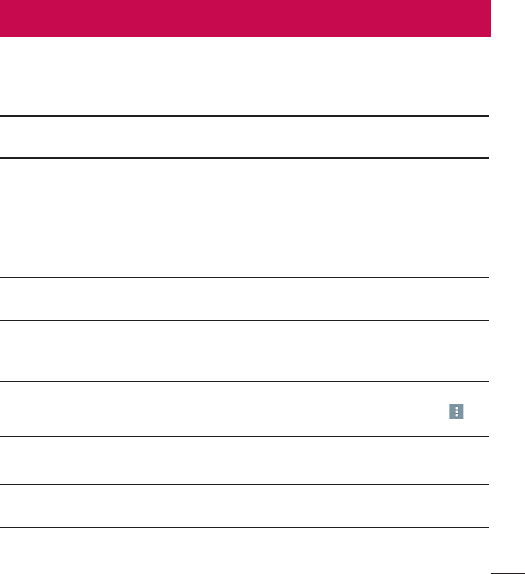
87
FAQ
Please check to see if any problems you have encountered with your phone are
described in this section before taking the phone in for service or calling a service
representative.
Category
Sub-Category Question Answer
Bluetooth
Bluetooth Devices
What are the
functions available via
Bluetooth?
You can connect Bluetooth audio devices such as
a Stereo/Mono headset or Car Kit. You can also
connect with compatible Bluetooth devices using the
Gallery and Contacts apps to share share pictures,
videos, contacts, etc. Also when an FTP server is
connected to a compatible device, you can share
contents stored in the phone's memory or in the
microSD card.
Data
Contacts Backup
How can I back up
Contacts?
The Contacts data can be synchronized between
your phone and Gmail
TM
.
Data
Synchronization
Is it possible to set up
one-way sync with Gmail? Only two-way synchronization is available.
Data
Synchronization
Is it possible to
synchronize all of the
Email folders?
The Inbox is automatically synchronized. You can
view other folders by tapping the Menu icon ,
then tapping Folders to choose a different folder.
Google
TM
Service
Gmail Log-In
Should I have to log into
Gmail whenever I want to
access Gmail?
Once you log in to Gmail, you don’t need to log
in again.
Google Service
Google Account
Is it possible to filter
emails? No, email filtering is not supported via the phone.

88
FAQ
Category
Sub-Category Question Answer
Phone Function
YouTube
TM
Is it possible to play
YouTube videos?
Yes, YouTube videos are supported but may have to
be viewed through the YouTube app (and not through
the Chrome app).
Phone Function
Email
What happens when I
execute another app while
writing an email?
Your email will automatically be saved as a draft.
Phone Function
Ringtone
Is there a file size
limitation for when I want
to use an MP3 file as a
ringtone?
There is no file size limitation.
Phone Function
Receiving Messages
My phone won't receive
messages anymore. How
can I fix this?
Your phone can't receive new messages when
there is less than 10MB of space available in the
phone's memory. Check your phone memory and
delete some data (such as messages, pictures, or
downloaded apps) to free up some space.
To check your phone memory:
From the Home screen, tap > Apps tab (if
necessary) > Settings > Storage.
Phone Function
Message Time
My phone does not
display the time of receipt
for messages older than
24 hrs. How can I change
this?
1. Open the message thread that contains the
message you want to check.
2. Touch and hold the message. Tap Details in the
Context menu that appears.
Phone Function
microSD Card
What is the maximum
supported size for a
memory card?
32 GB memory cards are compatible.
Phone Function
Navigation
Is it possible to install
another navigation app on
my phone?
Any app that is available on Play Store and is
compatible with the hardware can be installed
and used.
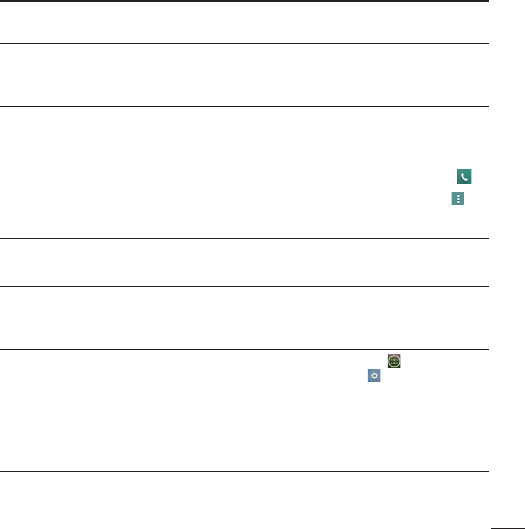
89
Category
Sub-Category Question Answer
Phone Function
Synchronization
Is it possible to
synchronize my contacts
from all of my email
accounts?
Only Gmail and MS Exchange server (Company
Email Server) contacts can be synchronized.
Phone Function
Wait and Pause
Is it possible to save a
contact with Wait and
Pause in the numbers?
If you transferred a contact with the wait and pause
functions saved into the number, they won't work.
You'll need to re-save each number.
How to re-save with Wait and Pause:
1. From the Home screen, tap the Phone icon .
2. Enter the number, then tap the Menu icon .
3. Tap Add 2-sec pause or Add wait, then continue
entering the numbers and save it.
Phone Function
Security
What are the phone’s
security functions?
You're able to set the phone to require the entry of a
screen unlock sequence (pattern, PIN, or password)
before the phone can be accessed or used.
Phone Function
Unlock Pattern
What should I do if I
forget my Unlock Pattern?
After 5 unsuccessful attempts, you can tap Forgot
Pattern? at the bottom of the screen and use your
Google Account information or Backup PIN to unlock
your phone.
Phone Function
Unlock Pattern
How do I create an Unlock
Pattern?
1. From the Home screen, tap > Apps tab (if
necessary) > Settings .
2. Tap Lock screen > Select screen lock
>
Pattern.
The first time you do this, a short tutorial about
creating a pattern appears.
3. Set it up by drawing your pattern once, then again
for confirmation.

90
FAQ
Category
Sub-Category Question Answer
Phone Function
Memory
Will I know when my
memory is full? Yes, you'll receive a notification.
Phone Function
Language Support
Is it possible to change
the language?
The phone has bilingual capabilities.
To change the language:
1. From the Home screen, tap , then tap
Settings .
2. Tap Language & input > Language
.
3. Tap the language you want to use.
Phone Function
VPN How do I set up a VPN?
VPN access configuration is different according
to each company. To configure VPN access from
your phone, you must obtain the details from your
company’s network administrator.
Phone Function
Screen timeout
My screen turns off after
only 15 seconds. How can
I change the amount of
time before the backlight
turns off?
1. From the Home screen, tap > Apps tab (if
necessary) > Settings > Display > Screen
timeout.
2. Tap the preferred screen backlight timeout time.
Phone Function
Audible tap tones
When I dial a number, the
phone plays tones. How
do I turn this off?
1. From the Home screen, tap > Apps tab (if
necessary) > Settings > Sound > Sound
effects.
2. Tap Dial pad touch tones to remove the
checkmark and disable the function.
Phone Function
Wi-Fi and 3G
When Wi-Fi and 3G are
both available, which
service will my phone
use?
When using data, your phone may default to the
Wi-Fi connection (if Wi-Fi connectivity on your phone
is set to On). However, there will be no notification
when your phone switches from one to the other.
To know which data connection is being used, view
the 3G or Wi-Fi icon in the Status Bar (at the top of
your screen).
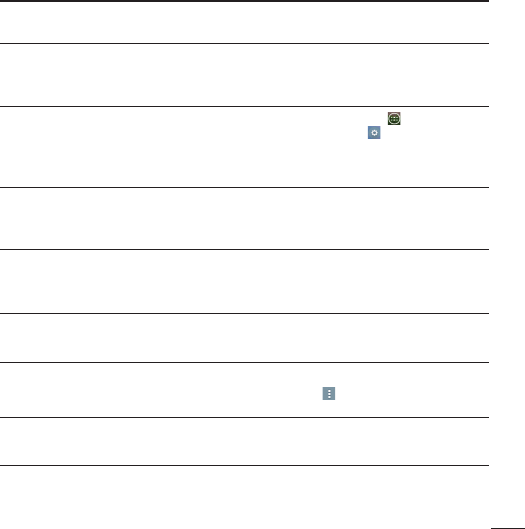
91
Category
Sub-Category Question Answer
Phone Function
Home screen
Is it possible to remove
an app from the Home
screen?
Yes. Touch and hold the icon until the trash can
icon appears at the top of the screen. Then, without
lifting your finger, drag the icon to the trash can and
lift your finger.
Phone Function
Application
I downloaded an app and
it causes a lot of errors.
How do I remove it?
1. From the Home screen, tap > Apps tab (if
necessary) > Settings > Apps.
2. Scroll to the DOWNLOADED apps tab, then tap
the app to uninstall.
3. Tap Uninstall and OK to confirm.
Phone Function
Charging
Is it possible to charge
my phone using the USB
Cable without installing
the necessary USB driver?
Yes, the USB Cable will allow the battery to be
charged by your PC whether or not the necessary
drivers have been installed on the PC.
Phone Function
Ringtones
Can I use music files for
my ringtone?
Yes. After saving a music file you can use it for
your ringtone.
Touch and hold a song in a library list. Tap Set as
ringtone
in the Context menu that appears.
Phone Function
Alarm
Will my alarm be audible
or will it go off if the
phone is turned off?
No, this is not supported.
Phone Function
Alarm
If my Ringer Volume is
set to Off or Vibrate, will I
hear my Alarm?
From the Alarm tab in the Alarm/Clock app, tap
the Menu icon > Settings. Checkmark Alarm
in silent mode.
Phone Spec
Band
Which wireless bands are
supported by the phone?
Your phone is able to operate on the GSM (850MHz,
900MHz,1800MHz,1900MHz), UMTS (850MHz,
1900MHz) bands.

92
FAQ
Category
Sub-Category Question Answer
Recovery Solution
Factory Reset
How do I perform a
factory reset?
1. From the Home screen, tap > Apps tab (if
necessary) > Settings > Backup & reset >
Factory data reset.
2. Read the warning, then tap Reset phone
.
3. Tap Delete all
and
OK
to confirm.
Attention:
If a factory reset is performed, all installed
apps and user data will be erased. Please
remember to back up any important data before
performing a factory reset.

93
For your safety
Safety Information
Please read and observe the following information for safe and proper use of your
phone and to prevent damage.
WARNING! This product contains chemicals known to the State of California to
cause cancer and birth defects or reproductive harm.
Wash hands after handling.
Caution: Violation of the instructions may cause minor or serious
damage to the product.
t For your safety, do not remove the battery incorporated in the product.
t Do not disassemble or open crush, bend or deform, puncture or shred.
t Repairs under warranty, at LG’s option, may include replacement parts or boards
that are either new or reconditioned, provided that they have functionality equal
to that of the parts being replaced.
t Do not modify or remanufacture, attempt to insert foreign objects into the
battery, immerse or expose to water or other liquids, expose to fire, explosion or
other hazard.
t Avoid dropping the phone. If the phone is dropped, especially on a hard surface,
and the user suspects damage, take it to a service center for inspection.
t For those host devices that utilize a USB port as a charging source, the host
device’s user manual shall include a statement that the phone shall only be
connected to products that bear the USB-IF logo or have completed the USB-IF
compliance program.

94
For your safety
Charger and Adapter Safety
t The charger and adapter are intended for indoor use only.
t Insert the battery pack charger vertically into the wall power socket.
t Unplug the power cord and charger during lightning storms to avoid electric
shock or fire.
t Use the correct adapter for your phone when using the battery pack charger
abroad.
Battery Information and Care
t Please read the manual of specified charger about charging method.
t Do not damage the power cord by bending, twisting, or heating. Do not use the
plug if it is loose as it may cause electric shock or fire. Do not place any heavy
items on the power cord. Do not allow the power cord to be crimped as it may
cause electric shock or fire.
t Unplug the power cord prior to cleaning your phone, and clean the power plug
pin when it’s dirty. When using the power plug, ensure that it’s firmly connected.
If not, it may cause excessive heat or fire. If you put your phone in a pocket
or bag without covering the receptacle of the phone (power plug pin), metallic
articles (such as a coin, paperclip or pen) may short-circuit the phone. Short-
circuit of the terminal may damage the battery and cause an explosion. Always
cover the receptacle when not in use.
t Charging temperature range is between 0°C/32°F and 45°C /113 °F. Do not
charge the battery out of recommended temperature range. Charging out of
recommended range might cause the generating heat or serious damage of

95
battery. And also, it might cause the deterioration of battery’s characteristics and
cycle life.
t The battery pack has protection circuit to avoid the danger. Do not use near
places that can generate static electricity more than 100V which could damage
the protection circuit. Damaged protection circuits may generate smoke, rupture
or ignite.
t When using the battery for the first time, if it emits a bad smell, you see rust on
it, or anything else abnormal, do not use the equipment and bring the battery to
the shop which it was bought.
t Do not handle the phone with wet hands while it is being charged. It may cause
an electric shock or seriously damage your phone.
t Do not place or answer calls while charging the phone as it may short-circuit the
phone and/or cause electric shock or fire.
t Do not use harsh chemicals (such as alcohol, benzene, thinners, etc.) or
detergents to clean your phone. This could cause a fire.
t Always unplug the charger from the wall socket after the phone is fully charged
to save unnecessary power consumption of the charger.
Care and Maintenance
Your mobile device is a product of superior design and craftsmanship and should
be treated with care. The suggestions below will help you fulfill any warranty
obligations and allow you to enjoy this product for many years:

96
For your safety
Keep your Mobile Device away from:
Liquids of any kind
Keep the mobile device dry. Precipitation, humidity, and liquids contain minerals
that will corrode electronic circuits. If the mobile device does get wet, do not
accelerate drying with the use of an oven, microwave, or dryer, because this may
damage the mobile device and could cause a fire or explosion.
Do not use the mobile device with a wet hand.
Doing so may cause an electric shock to you or damage to the mobile device.
Extreme heat or cold
t Avoid temperatures below 0°C /32°F or above 45°C /113°F.
t Use your phone in temperatures between 0°C /32°F and 40°C /104°F, if
possible. Exposing your phone to extremely low or high temperatures may result
in damage, malfunction, or even explosion.
Microwaves
Do not try to dry your mobile device in a microwave oven. Doing so may cause a
fire or explosion.
Dust and dirt
Do not expose your mobile device to dust, dirt, or sand.
Sunscreen lotion
Do not expose or wear your device to any liquid like sunscreen lotion.
Doing so may cause your device to or damage to the mobile device.

97
Cleaning solutions
Do not use harsh chemicals, cleaning solvents, or strong detergents to clean the
mobile device.
Wipe it with a soft cloths lightly dampened in a mild soap-and-water solution.
Shock or vibration
Do not drop, knock, or shake the mobile device.
Rough handling can break internal circuit boards.
Paint
Do not paint the mobile device. Paint can clog the device’smoving parts or
ventilation openings and prevent proper operation.
General Notice
t An emergency call can be made only within a service area. For an emergency
call, make sure that you are within a service area and that the phone is turned
on.
t Do not place items containing magnetic components such as a credit card,
phone card, bank book, or subway ticket near your phone. The magnetism of the
phone may damage the data stored in the magnetic strip.
t Talking on your phone for a long period of time may reduce call quality due to
heat generated during use.
t When the phone is not used for a long period time, store it in a safe place with
the power cord unplugged.
t Using the phone in proximity to receiving equipment (i.e., TV or radio) may cause
interference to the phone.

98
For your safety
t Do not use the phone if the antenna is damaged. If a damaged antenna contacts
skin, it may cause a slight burn. Please contact an LG Authorized Service Center
to replace the damaged antenna.
t The data saved in your phone might be deleted due to careless use, repair of
the phone, or upgrade of the software. Please backup your important phone
numbers. (Ringtones, text messages, voice messages, pictures, and videos could
also be deleted.) The manufacturer is not liable for damage due to the loss of
data.
t When you use the phone in public places, set the ringtone to vibration so you
don’t disturb others.
t Do not turn your phone on or off when putting it to your ear.
t Your phone is an electronic device that generates heat during normal operation.
Extremely prolonged, direct skin contact in the absence of adequate ventilation
may result in discomfort or minor burns. Therefore, use care when handling your
phone during or immediately after operation.
Use accessories, such as earphones and headsets, with caution. Ensure that
cables are tucked away safely and do not touch the antenna unnecessarily.
Part 15.19 statement
This device complies with part 15 of FCC rules. Operation is subject to the
following two conditions:
(1) This device may not cause harmful interference, and (2) this device must
accept any interference received, including interference that causes undesired
operation.

99
Bodily Contact During Operation
This device was tested for typical use with the back of the phone kept 0.59
inches (1.5 cm) from the body. To comply with FCC RF exposure requirements,
a minimum separation distance of 0.59 inches (1.5 cm) must be maintained
between the user’s body and the back of the phone. Third-party belt-clips,
holsters, and similar accessories containing metallic components may not be used.
Avoid the use of accessories that cannot maintain 0.59 inches (1.5 cm) distance
between the user’s body and the back of the phone and have not been tested for
compliance with FCC RF exposure limits.
Consumer Information About Radio Frequency Emissions
Your wireless phone, which contains a radio transmitter and receiver, emits radio
frequency energy during use. The following consumer information addresses
commonly asked questions about the health effects of wireless phones.
Are wireless phones safe?
Scientific research on the subject of wireless phones and radio frequency
(“RF”) energy has been conducted worldwide for many years, and continues.
In the United States, the Food and Drug Administration (“FDA”) and the Federal
Communications Commission (“FCC”) set policies and procedures for wireless
phones. The FDA issued a website publication on health issues related to cell
phone usage where it states, “The scientific community at large …believes that
the weight of scientific evidence does not show an association between exposure
to radiofrequency (RF) from cell phones and adverse health outcomes. Still the
scientific community does recommend conducting additional research to address

100
For your safety
gaps in knowledge. That research is being conducted around the world and FDA
continues to monitor developments in this field. You can access the joint FDA/
FCC website at http://www.fda.gov (under “c” in the subject index, select Cell
Phones > Research). You can also contact the FDA toll-free at (888) 463-6332
or (888) INFO-FDA. In June 2000, the FDA entered into a cooperative research
and development agreement through which additional scientific research is being
conducted. The FCC issued its own website publication stating that “there is no
scientific evidence that proves that wireless phone usage can lead to cancer or a
variety of other problems, including headaches, dizziness or memory loss.” This
publication is available at http://www.fcc.gov/cgb/cellular.html or through the FCC
at (888) 225-5322 or (888) CALL-FCC.
What does “SAR” mean?
In 1996, the FCC, working with the FDA, the U.S. Environmental Protection Agency,
and other agencies, established RF exposure safety guidelines for wireless phones
in the United States. Before a wireless phone model is available for sale to the
public, it must be tested by the manufacturer and certified to the FCC that it does
not exceed limits established by the FCC. One of these limits is expressed as a
Specific Absorption Rate, or “SAR.” SAR is a measure of the rate of absorption of
RF energy in the body. Tests for SAR are conducted with the phone transmitting
at its highest power level in all tested frequency bands. Since 1996, the FCC
has required that the SAR of handheld wireless phones not exceed 1.6 watts per
kilogram, averaged over one gram of tissue. Although the SAR is determined at
the highest power level, the actual SAR value of a wireless phone while operating
can be less than the reported SAR value. This is because the SAR value may vary

101
from call to call, depending on factors such as proximity to a cell site, the proximity
of the phone to the body while in use, and the use of hands-free devices. For
more information about SARs, see the FCC’s OET Bulletins 56 and 65 at http://
www.fcc.gov/Bureaus/Engineering_Technology/Documents/bulletins or visit the
Cellular Telecommunications Industry Association website at http://www.ctia.
org/consumer_info/index.cfm/AID/10371. You may also wish to contact the
manufacturer of your phone.
Can I minimize my RF exposure?
If you are concerned about RF, there are several simple steps you can take to
minimize your RF exposure. You can, of course, reduce your talk time. You can
place more distance between your body and the source of the RF, as the exposure
level drops off dramatically with distance. The FDA/FCC website states that
“hands-free kits can be used with wireless phones for convenience and comfort.
These systems reduce the absorption of RF energy in the head because the
phone, which is the source of the RF emissions, will not be placed against the
head. On the other hand, if the phone is mounted against the waist or other part
of the body during use, then that part of the body will absorb more RF energy.
Wireless phones marketed in the U.S. are required to meet safety requirements
regardless of whether they are used against the head or against the body. Either
configuration should result in compliance with the safety limit.”Also, if you use
your wireless phone while in a car, you can use a phone with an antenna on
the outside of the vehicle. You should also read and follow your wireless phone
manufacturer’s instructions for the safe operation of your phone.

102
For your safety
Do wireless phones pose any special risks to children?
The FDA/FCC website states that “the scientific evidence does not show a danger
to users of wireless communication devices, including children.” The FDA/FCC
website further states that “some groups sponsored by other national governments
have advised that children be discouraged from using wireless phones at all”.
For example, the Stewart Report from the United Kingdom [“UK”] made such a
recommendation in December 2000. In this report a group of independent experts
noted that no evidence exists that using a cell phone causes brain tumors or
other ill effects. [The UK’s] recommendation to limit cell phone use by children
was strictly precautionary; it was not based on scientific evidence that any health
hazard exists. A copy of the UK’s leaflet is available at http://www.dh.gov.uk
(search “mobile”), or you can write to: NRPB, Chilton, Didcot, Oxon OX11 ORQ,
United Kingdom. Copies of the UK’s annual reports on mobile phones and RF
are available online at www.iegmp.org.uk and http://www.hpa.org.uk/radiation/
(search “mobile”). Parents who wish to reduce their children’s RF exposure may
choose to restrict their children’s wireless phone use.
Where can I get further information about RF emissions?
For further information, see the following additional resources (websites current as
of April 2005):
U.S. Food and Drug Administration
FDA Consumer magazine November-December 2000 Telephone: (888) INFO-FDA
http://www.fda.gov (Under “c”in the subject index, select Cell Phones > Research.)

103
U.S. Federal Communications Commission
445 12th Street, S.W. Washington, D.C. 20554 Telephone: (888) 225-5322 http://
www.fcc.gov/oet/rfsafety
Independent Expert Group on Mobile Phones
http://www.iegmp.org.uk
Royal Society of Canada Expert Panels on Potential
Health Risks of Radio Frequency Fields from Wireless
Telecommunication Devices
283 Sparks Street Ottawa, Ontario K1R 7X9 Canada Telephone: (613) 991-6990
http://www.rsc.ca/index.php?page=Expert_Panels_RF&Lang_id=120
World Health Organization
Avenue Appia 20
1211 Geneva 27
Switzerland
Telephone: 011 41 22 791 21 11
http://www.who.int/mediacentre/factsheets/fs193/en/
International Commission on Non-Ionizing
Radiation Protection c/o Bundesamt fur Strahlenschutz
Ingolstaedter Landstr. 1
85764 Oberschleissheim

104
For your safety
Germany
Telephone: 011 49 1888 333 2156
http://www.icnirp.de
American National Standards Institute
1819 L Street, N.W., 6th Floor
Washington, D.C. 20036
Telephone: (202) 293-8020
http://www.ansi.org
National Council on Radiation Protection and
Measurements
7910 Woodmont Avenue, Suite 800
Bethesda, MD 20814-3095
Telephone: (301) 657-2652
http://www.ncrponline.org
Engineering in Medicine and Biology Society, Committee
on Man and Radiation (COMAR) of the Institute of Electrical
and Electronics Engineers
http://ewh.ieee.org/soc/embs/comar/
TIA Safety Information
The following is the complete TIA Safety Information for wireless handheld phones.

105
Exposure to Radio Frequency Signal
Your wireless handheld portable phone is a low power radio transmitter and
receiver. When ON, it receives and sends out Radio Frequency (RF) signals.
In August, 1996, the Federal Communications Commissions (FCC) adopted
RF exposure guidelines with safety levels for handheld wireless phones. Those
guidelines are consistent with the safety standards previously set by both U.S. and
international standards bodies:
ANSI C95.1 (1992) *
NCRP Report 86 (1986)
ICNIRP (1996)
* American National Standards Institute; National Council on Radiation Protection
and Measurements; International Commission on Non-Ionizing Radiation
Protection
Those standards were based on comprehensive and periodic evaluations of the
relevant scientific literature. For example, over 120 scientists, engineers, and
physicians from universities, government health agencies, and industry reviewed
the available body of research to develop the ANSI Standard (C95.1).
The design of your phone complies with the FCC guidelines (and those standards).
Antenna Care
Use only the supplied or an approved replacement antenna. Unauthorized
antennas, modifications, or attachments could damage the phone and may violate
FCC regulations.

106
For your safety
Phone Operation
NORMAL POSITION: Hold the phone as you would any other telephone with the
antenna pointed up and over your shoulder.
Tips on Efficient Operation
For your phone to operate most efficiently:
Don’t touch the antenna unnecessarily when the phone is in use. Contact with the
antenna affects call quality and may cause the phone to operate at a higher power
level than otherwise needed.
Electronic Devices
Most modern electronic equipment is shielded from RF signals. However, certain
electronic equipment may not be shielded against the RF signals from your
wireless phone.
Pacemakers
The Health Industry Manufacturers Association recommends that a minimum
separation of six (6) inches be maintained between a handheld wireless
phone and a pacemaker to avoid potential interference with the pacemaker.
These recommendations are consistent with the independent research by and
recommendations of Wireless Technology Research.
Persons with pacemakers:
t Should ALWAYS keep the phone more than six (6) inches from their pacemaker
when the phone is turned ON;
t Should not carry the phone in a breast pocket;

107
t Should use the ear opposite the pacemaker to minimize the potential for
interference;
t Should turn the phone OFF immediately if there is any reason to suspect that
interference is taking place.
Hearing Aids
Some digital wireless phones may interfere with some hearing aids. In the event
of such interference, you may want to consult your service provider (or call the
customer service line to discuss alternatives).
Other Medical Devices
If you use any other personal medical device, consult the manufacturer of your
device to determine if it is adequately shielded from external RF energy. Your
physician may be able to assist you in obtaining this information.
Health Care Facilities
Turn your phone OFF in health care facilities when any regulations posted in these
areas instruct you to do so. Hospitals or health care facilities may use equipment
that could be sensitive to external RF energy.
Vehicles
RF signals may affect improperly installed or inadequately shielded electronic
systems in motor vehicles. Check with the manufacturer or its representative
regarding your vehicle. You should also consult the manufacturer of any equipment
that has been added to your vehicle.
Posted Facilities
Turn your phone OFF in any facility where posted notices so require.

108
For your safety
Aircraft
FCC regulations prohibit using your phone while in the air. Switch OFF your phone
before boarding an aircraft.
Blasting Areas
To avoid interfering with blasting operations, turn your phone OFF when in a
“blasting area” or in areas posted: “Turn off two-way radio”. Obey all signs and
instructions.
Potentially Explosive Atmosphere
Turn your phone OFF when in any area with a potentially explosive atmosphere
and obey all signs and instructions. Sparks in such areas could cause an explosion
or fire resulting in bodily injury or even death.
Areas with a potentially explosive atmosphere are often, but not always marked
clearly. Potential areas may include: fueling areas (such as gasoline stations);
below deck on boats; fuel or chemical transfer or storage facilities; vehicles using
liquefied petroleum gas (such as propane or butane); areas where the air contains
chemicals or particles (such as grain, dust, or metal powders); and any other area
where you would normally be advised to turn off your vehicle engine.
For Vehicles Equipped with an Air Bag
An air bag inflates with great force. DO NOT place objects, including either
installed or portable wireless equipment, in the area over the air bag or in the air
bag deployment area. If in-vehicle wireless equipment is improperly installed and
the air bag inflates, serious injury could result.

109
FDA Consumer Update
The U.S. Food and Drug Administration’s Center for Devices and
Radiological Health Consumer Update on Mobile Phones:
1. Do wireless phones pose a health hazard?
The available scientific evidence does not show that any health problems are
associated with using wireless phones.
There is no proof, however, that wireless phones are absolutely safe. Wireless
phones emit low levels of Radio Frequency (RF) energy in the microwave range
while being used. They also emit very low levels of RF when in idle mode. Whereas
high levels of RF can produce health effects (by heating tissue), exposure to low
level RF that does not produce heating effects causes no known adverse health
effects. Many studies of low level RF exposures have not found any biological
effects. Some studies have suggested that some biological effects may occur,
but such findings have not been confirmed by additional research. In some
cases, other researchers have had difficulty in reproducing those studies, or in
determining the reasons for inconsistent results.
2. What is the FDA’s role concerning the safety of wireless phones?
Under the law, the FDA does not review the safety of radiation-emitting consumer
products such as wireless phones before they can be sold, as it does with new
drugs or medical devices. However, the agency has authority to take action if
wireless phones are shown to emit Radio Frequency (RF) energy at a level that is
hazardous to the user. In such a case, the FDA could require the manufacturers of
wireless phones to notify users of the health hazard and to repair, replace, or recall
the phones so that the hazard no longer exists.

110
For your safety
Although the existing scientific data does not justify FDA regulatory actions, the
FDA has urged the wireless phone industry to take a number of steps, including
the following:
t Support needed research into possible biological effects of RF of the type
emitted by wireless phones;
t Design wireless phones in a way that minimizes any RF exposure to the user
that is not necessary for device function; and
t Cooperate in providing users of wireless phones with the best possible
information on possible effects of wireless phone use on human health.
The FDA belongs to an interagency working group of the federal agencies that
have responsibility for different aspects of RF safety to ensure coordinated efforts
at the federal level. The following agencies belong to this working group:
t National Institute for Occupational Safety and Health
t Environmental Protection Agency
t Occupational Safety and Health Administration
t National Telecommunications and Information Administration
The National Institutes of Health participates in some interagency working group
activities, as well.
The FDA shares regulatory responsibilities for wireless phones with the Federal
Communications Commission (FCC). All phones that are sold in the United States
must comply with FCC safety guidelines that limit RF exposure. The FCC relies on
the FDA and other health agencies for safety questions about wireless phones.
The FCC also regulates the base stations that the wireless phone networks rely
upon. While these base stations operate at higher power than do the wireless
phones themselves, the RF exposures that people get from these base stations are

111
typically thousands of times lower than those they can get from wireless phones.
Base stations are thus not the subject of the safety questions discussed in this
document.
3. What kinds of phones are the subject of this update?
The term “wireless phone” refers here to handheld wireless phones with built-in
antennas, often called “cell”, “mobile”, or “PCS” phones. These types of wireless
phones can expose the user to measurable Radio Frequency (RF) energy because
of the short distance between the phone and the user’s head. These RF exposures
are limited by FCC safety guidelines that were developed with the advice of the
FDA and other federal health and safety agencies. When the phone is located at
greater distances from the user, the exposure to RF is drastically lower because
a person’s RF exposure decreases rapidly with increasing distance from the
source. The so-called “cordless phones,” which have a base unit connected to the
telephone wiring in a house, typically operate at far lower power levels, and thus
produce RF exposures far below the FCC safety limits.
4. What are the results of the research done already?
The research done thus far has produced conflicting results, and many studies
have suffered from flaws in their research methods. Animal experiments
investigating the effects of Radio Frequency (RF) energy exposures characteristic
of wireless phones have yielded conflicting results that often cannot be repeated in
other laboratories. A few animal studies, however, have suggested that low levels
of RF could accelerate the development of cancer in laboratory animals. However,
many of the studies that showed increased tumor development used animals that
had been genetically engineered or treated with cancer-causing chemicals so as
to be pre-disposed to develop cancer in the absence of RF exposure. Other studies

112
For your safety
exposed the animals to RF for up to 22 hours per day. These conditions are not
similar to the conditions under which people use wireless phones, so we do not
know with certainty what the results of such studies mean for human health.
Three large epidemiology studies have been published since December 2000.
Between them, the studies investigated any possible association between the use
of wireless phones and primary brain cancer, glioma, meningioma, or acoustic
neuroma, tumors of the brain or salivary gland, leukemia, or other cancers. None
of the studies demonstrated the existence of any harmful health effects from
wireless phone RF exposures. However, none of the studies can answer questions
about long-term exposures, since the average period of phone use in these
studies was around three years.
5. What research is needed to decide whether RF exposure from wireless
phones poses a health risk?
A combination of laboratory studies and epidemiological studies of people actually
using wireless phones would provide some of the data that are needed. Lifetime
animal exposure studies could be completed in a few years. However, 166 very
large numbers of animals would be needed to provide reliable proof of a cancer
promoting effect if one exists. Epidemiological studies can provide data that is
directly applicable to human populations, but ten or more years followup may
be needed to provide answers about some health effects, such as cancer. This
is because the interval between the time of exposure to a cancercausing agent
and the time tumors develop — if they do — may be many, many years. The
interpretation of epidemiological studies is hampered by difficulties in measuring
actual RF exposure during day-to-day use of wireless phones. Many factors affect

113
this measurement, such as the angle at which the phone is held, or which model
of phone is used.
6. What is the FDA doing to find out more about the possible health effects
of wireless phone RF?
The FDA is working with the U.S. National Toxicology Program and with groups
of investigators around the world to ensure that high priority animal studies are
conducted to address important questions about the effects of exposure to Radio
Frequency (RF) energy.
The FDA has been a leading participant in the World Health Organization
International Electro Magnetic Fields (EMF) Project since its inception in 1996.
An influential result of this work has been the development of a detailed agenda
of research needs that has driven the establishment of new research programs
around the world. The project has also helped develop a series of public
information documents on EMF issues.
The FDA and the Cellular Telecommunications & Internet Association (CTIA) have a
formal Cooperative Research And Development Agreement (CRADA)
to do research on wireless phone safety. The FDA provides the scientific oversight,
obtaining input from experts in government, industry, and academic organizations.
CTIA-funded research is conducted through contracts with independent
investigators. The initial research will include both laboratory studies and studies
of wireless phone users. The CRADA will also include a broad assessment of
additional research needs in the context of the latest research developments
around the world.

114
For your safety
7. How can I find out how much Radio Frequency energy exposure I can get
by using my wireless phone?
All phones sold in the United States must comply with Federal Communications
Commission (FCC) guidelines that limit Radio Frequency (RF) energy exposures.
The FCC established these guidelines in consultation with the FDA and the other
federal health and safety agencies. The FCC limit for RF exposure from wireless
phones is set at a Specific Absorption Rate (SAR) of 1.6 watts per kilogram (1.6
W/kg). The FCC limit is consistent with the safety standards developed by the
Institute of Electrical and Electronic Engineering (IEEE) and the National Council on
Radiation Protection and Measurement. The exposure limit takes into consideration
the body’s ability to remove heat from the tissues that absorb energy from the
wireless phone and is set well below levels known to have effects. Manufacturers
of wireless phones must report the RF exposure level for each model of phone
to the FCC. The FCC website (http://www.fcc.gov/oet/rfsafety) gives directions for
locating the FCC identification number on your phone so you can find your phone’s
RF exposure
level in the online listing.
8. What has the FDA done to measure the Radio Frequency energy coming
from wireless phones?
The Institute of Electrical and Electronic Engineers (IEEE) is developing a technical
standard for measuring the Radio Frequency (RF) energy exposure from wireless
phones and other wireless handsets with the participation and leadership of FDA
scientists and engineers. The standard, “Recommended Practice for Determining
the Spatial-Peak Specific Absorption Rate (SAR) in the Human Body Due to
Wireless Communications Devices: Experimental Techniques”, sets forth the first

115
consistent test methodology for measuring the rate at which RF is deposited in the
heads of wireless phone users. The test method uses a tissue-simulating model
of the human head. Standardized SAR test methodology is expected to greatly
improve the consistency of measurements made at different laboratories on the
same phone. SAR is the measurement of the amount of energy absorbed in tissue,
either by the whole body or a small part of the body. It is measured in watts/kg (or
milliwatts/g) of matter. This measurement is used to determine whether a wireless
phone complies with safety guidelines.
9. What steps can I take to reduce my exposure to Radio Frequency energy
from my wireless phone?
If there is a risk from these products — and at this point we do not know that
there is — it is probably very small. But if you are concerned about avoiding
even potential risks, you can take a few simple steps to minimize your exposure
to Radio Frequency (RF) energy. Since time is a key factor in how much exposure
a person receives, reducing the amount of time spent using a wireless phone
will reduce RF exposure. If you must conduct extended conversations by wireless
phone every day, you could place more distance between your body and the
source of the RF, since the exposure level drops off dramatically with distance. For
example, you could use a headset and carry the wireless phone away from your
body or use a wireless phone connected to a remote antenna. Again, the scientific
data does not demonstrate that wireless phones are harmful. But if you are
concerned about the RF exposure from these products, you can use measures like
those described above to reduce your RF exposure from wireless phone use.

116
For your safety
10. What about children using wireless phones?
The scientific evidence does not show a danger to users of wireless phones,
including children and teenagers. If you want to take steps to lower exposure
to Radio Frequency (RF) energy, the measures described above would apply to
children and teenagers using wireless phones. Reducing the time of wireless
phone use and increasing the distance between the user and the RF source will
reduce RF exposure.
Some groups sponsored by other national governments have advised that children
be discouraged from using wireless phones at all. For example, the government
in the United Kingdom distributed leaflets containing such a recommendation in
December 2000. They noted that no evidence exists that using a wireless phone
causes brain tumors or other ill effects. Their recommendation to limit wireless
phone use by children was strictly precautionary; it was not based on scientific
evidence that any health hazard exists.
11. What about wireless phone interference with medical equipment?
Radio Frequency (RF) energy from wireless phones can interact with some
electronic devices. For this reason, the FDA helped develop a detailed test
method to measure Electro Magnetic Interference (EMI) of implanted cardiac
pacemakers and defibrillators from wireless telephones. This test method is
now part of a standard sponsored by the Association for the Advancement of
Medical Instrumentation (AAMI). The final draft, a joint effort by the FDA, medical
device manufacturers, and many other groups, was completed in late 2000.
This standard will allow manufacturers to ensure that cardiac pacemakers and
defibrillators are safe from wireless phone EMI.

117
The FDA has tested hearing aids for interference from handheld wireless
phones and helped develop a voluntary standard sponsored by the Institute of
Electrical and Electronic Engineers (IEEE). This standard specifies test methods
and performance requirements for hearing aids and wireless phones so that no
interference occurs when a person uses a “compatible” phone and a “compatible”
hearing aid at the same time. This standard was approved by the IEEE in 2000.
The FDA continues to monitor the use of wireless phones for possible interactions
with other medical devices. Should harmful interference be found to occur, the
FDA will conduct testing to assess the interference and work to resolve the
problem.
12. Where can I find additional information?
For additional information, please refer to the following resources:
Federal Communications Commission (FCC) RF Safety Program
(http://www.fcc.gov/oet/rfsafety)
International Commission on Non-lonizing Radiation Protection
(http://www.icnirp.de)
World Health Organization (WHO) International EMF Project
(http://www.who.int/emf)
National Radiological Protection Board (UK)
(http://www.hpa.org.uk/radiation/)

118
For your safety
Driving
Check the laws and regulations on the use of wireless phones in the areas where
you drive and always obey them. Also, if using your phone while driving, please
observe the following:
t Give full attention to driving -- driving safely is your first responsibility;
t Use hands-free operation, if available;
t Pull off the road and park before making or answering a call if driving conditions
or the law require it.
Consumer Information on SAR
(Specific Absorption Rate)
This model phone meets the Government’s requirements for exposure to radio
waves. Your wireless phone is a radio transmitter and receiver. It is designed and
manufactured not to exceed the emission limits for exposure to radiofrequency
(RF) energy set by the Federal Communications Commission (FCC) of the U.S.
Government. These FCC exposure limits are derived from the recommendations
of two expert organizations, the National Counsel on Radiation Protection and
Measurement (NCRP) and the Institute of Electrical and Electronics Engineers
(IEEE). In both cases, the recommendations were developed by scientific and
engineering experts drawn from industry, government, and academia after
extensive reviews of the scientific literature related to the biological effects of RF
energy.
The exposure limit for wireless mobile phones employs a unit of measurement
known as the Specific Absorption Rate, or SAR. The SAR is a measure of the

119
rate of absorption of RF energy by the human body expressed in units of watts
per kilogram (W/kg). The FCC requires wireless phones to comply with a safety
limit of 1.6 watts per kilogram (1.6 W/kg). The FCC exposure limit incorporates
a substantial margin of safety to give additional protection to the public and to
account for any variations in measurements.
Tests for SAR are conducted using standard operating positions specified by the
FCC with the phone transmitting at its highest certified power level in all tested
frequency bands. Although SAR is determined at the highest certified power level,
the actual SAR level of the phone while operating can be well below the maximum
value. Because the phone is designed to operate at multiple power levels to use
only the power required to reach the network, in general, the closer you are to a
wireless base station antenna, the lower the power output.
Before a phone model is available for sale to the public, it must be tested and
certified to the FCC that it does not exceed the limit established by the government
adopted requirement for safe exposure. The tests are performed in positions and
locations (e.g., at the ear and worn on the body) as required by the FCC for each
model.
The FCC has granted an Equipment Authorization for this model phone with
all reported SAR levels evaluated as in compliance with the FCC RF emission
guidelines.
The highest SAR value for this model phone when tested for use at the ear is
1.08 W/Kg (1g) and when worn on the body, as described in this user’s manual,
is 0.89 W/Kg (1g). While there may be differences between SAR levels of various
phones and at various positions, they all meet the government requirement for
safe exposure.

120
For your safety
SAR information on this model phone is on file with the FCC and can be found
under the Display Grant section of
http://www.fcc.gov/oet/ea/fccid/ after searching on FCC ID ZNFL15G.
To find information that pertains to a particular model phone, this site uses the
phone FCC ID number which is usually printed somewhere on the case of the
phone. Sometimes it may be necessary to remove the battery pack to find the
number. Once you have the FCC ID number for a particular phone, follow the
instructions on the website and it should provide values for typical or maximum
SAR for a particular phone.
Additional information on Specific Absorption Rates (SAR) can be found on the
Cellular Telecommunications Industry Association (CTIA) website at
http://www.ctia.org/
*In the United States and Canada, the SAR limit for mobile phones used by the
public is 1.6 watts/kg (W/kg) averaged over one gram of tissue. The standard
incorporates a substantial margin of safety to give additional protection for the
public and to account for any variations in measurements.
HAC
This phone has been tested and rated for use with hearing aids for some of the
wireless technologies that it uses.
However, there may be some newer wireless technologies used in this phone
that have not been tested yet for use with hearing aids. It is important to try the
different features of this phone thoroughly and in different locations, using your
hearing aid or cochlear implant, to determine if you hear any interfering noise.
Consult your service provider or the manufacturer of this phone for information on

121
hearing aid compatibility. If you have questions about return or exchange policies,
consult your service provider or phone retailer.
FCC Hearing-Aid Compatibility (HAC) Regulations for
Wireless Devices
On July 10, 2003, the U.S. Federal Communications Commission (FCC) Report
and Order in WT Docket 01-309 modified the exception of wireless phones under
the Hearing Aid Compatibility Act of 1988 (HAC Act) to require digital wireless
phones be compatible with hearing-aids. The intent of the HAC Act is to ensure
reasonable access to telecommunications services for persons with hearing
disabilities.
While some wireless phones are used near some hearing devices (hearing aids
and cochlear implants), users may detect a buzzing, humming, or whining noise.
Some hearing devices are more immune than others to this interference noise,
and phones also vary in the amount of interference they generate.
The wireless telephone industry has developed a rating system for wireless
phones, to assist hearing device users to find phones that may be compatible with
their hearing devices. Not all phones have been rated. Phones that are rated have
the rating on their box or a label located on the box.
The ratings are not guarantees. Results will vary depending on the user’s hearing
device and hearing loss. If your hearing device happens to be vulnerable to
interference, you may not be able to use a rated phone successfully. Trying out
the phone with your hearing device is the best way to evaluate it for your personal
needs.

122
For your safety
M-Ratings: Phones rated M3 or M4 meet FCC requirements and are likely to
generate less interference to hearing devices than phones that are not labeled. M4
is the better/ higher of the two ratings.
T-Ratings: Phones rated T3 or T4 meet FCC requirements and are likely to
generate less interference to hearing devices than phones that are not labeled. T4
is the better/ higher of the two ratings.
Hearing devices may also be rated. Your hearing device manufacturer or hearing
health professional may help you find this rating.
Higher ratings mean that the hearing device is relatively immune to interference
noise.
The hearing aid and wireless phone rating values are then added together. A sum
of 5 is considered acceptable for normal use. A sum of 6 is considered for best
use.
In the example to the left, if a hearing aid meets the M2 level
rating and the wireless phone meets the M3 level rating, the
sum of the two values equal M5. This should provide the
hearing aid user with “normal usage” while using their
hearing aid with the particular wireless phone. “Normal
usage” in this context is defined as a signal quality that’s acceptable for normal
operation.
The M mark is intended to be synonymous with the U mark. The T mark
is intended to be synonymous with the UT mark. The M and T marks are
recommended by the Alliance for Telecommunications Industries Solutions (ATIS).
The U and UT marks are referenced in Section 20.19 of the FCC Rules. The
HAC rating and measurement procedure are described in the American National

123
Standards Institute (ANSI) C63.19 standard. To ensure that the Hearing Aid
Compatibility rating for your phone is maintained, secondary transmitters such as
Bluetooth and WLAN components must be disabled during a call.
When you’re talking on a cell phone, it’s recommended that you turn the BT
(Bluetooth) or WLAN mode off for HAC.
For information about hearing aids and digital wireless phones
Wireless Phones and Hearing Aid Accessibility
http://www.accesswireless.org/
Gallaudet University, RERC
http://tap.gallaudet.edu/Voice/
FCC Hearing Aid Compatibility and Volume Control
http://www.fcc.gov/cgb/dro/hearing.html
The Hearing Aid Compatibility FCC Order
http://hraunfoss.fcc.gov/edocs_public/attachmatch/FCC-03-168A1.pdf
Hearing Loss Association of America [HLAA]
http://hearingloss.org/content/telephones-and-mobile-devices
Part 15.105 statement
This equipment has been tested and found to comply with the limits for a class
B digital device, pursuant to Part 15 of the FCC rules. These limits are designed
to provide reasonable protection against harmful interference in a residential
installation. This equipment generates, uses, and can radiate radio frequency
energy and, if not installed and used in accordance with the instructions,
may cause harmful interference to radio communications. However, there is

124
For your safety
no guarantee that interference will not occur in a particular installation. If this
equipment does cause harmful interference or television reception, which can be
determined by turning the equipment off and on, the user is encouraged to try to
correct the interference by one or more of the following measures:
- Reorient or relocate the receiving antenna.
- Increase the separation between the equipment and receiver.
- Connect the equipment into an outlet on a circuit different from that to which the
receiver is connected.
- Consult the dealer or an experienced radio/TV technician for help.
* Service not available everywhere.
* Information subject to change.
Part 15.21 statement
Changes or modifications that are not expressly approved by the manufacturer
could void the user’s authority to operate the equipment.
Battery information and care
Always unplug the charger from the wall socket after the phone is fully charged to
save unnecessary power consumption of the charger.

125
7.11 Warranty Laws
The following laws govern warranties that arise in retail sales of consumer
goods:
t5IF$BMJGPSOJB4POH#FWFSMZ$POTVNFS8BSSBOUZ"DU<$$ffFUTFR>
t5IF$BMJGPSOJB6OJGPSN$PNNFSDJBM$PEF%JWJTJPO5XP<$PN$ffFU
seq], and
t5IFGFEFSBM.BHOVTPO.PTT8BSSBOUZ'FEFSBM5SBEF$PNNJTTJPO
*NQSPWFNFOU"DU<64$ffFUTFR$'31BSUTo>
A typical Magnuson-Moss Act warranty is a written promise that the
product is free of defects or a written promise to refund, repair, or replace
EFGFDUJWFHPPET<4FF64$f>3FNFEJFTJODMVEFEBNBHFT
for failing to honor a written warranty or service contract or for violating
EJTDMPTVSFQSPWJTJPOT<4FF64$fE>&YDFQUGPSTPNFMBCFMJOH
and disclosure requirements, the federal Act does not preempt state law.
<4FF64$f>
The Consumer Warranty Act does not affect the rights and obligations of
parties under the state Uniform Commercial Code, except the provisions of
the Act prevail over provisions of the Commercial Code when they conflict.
<$$ůf>
For purposes of small claims actions, this course will focus on rights and
duties under the state laws.


